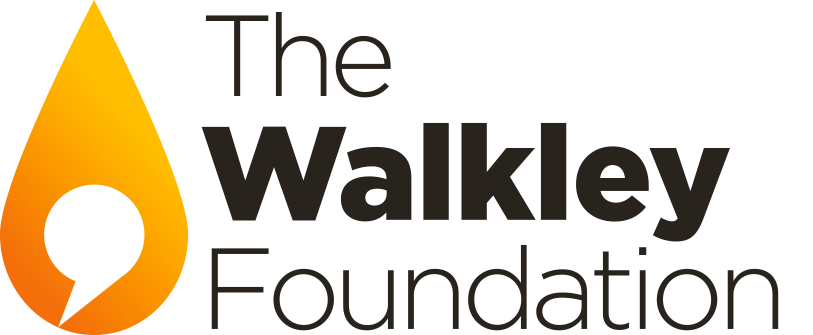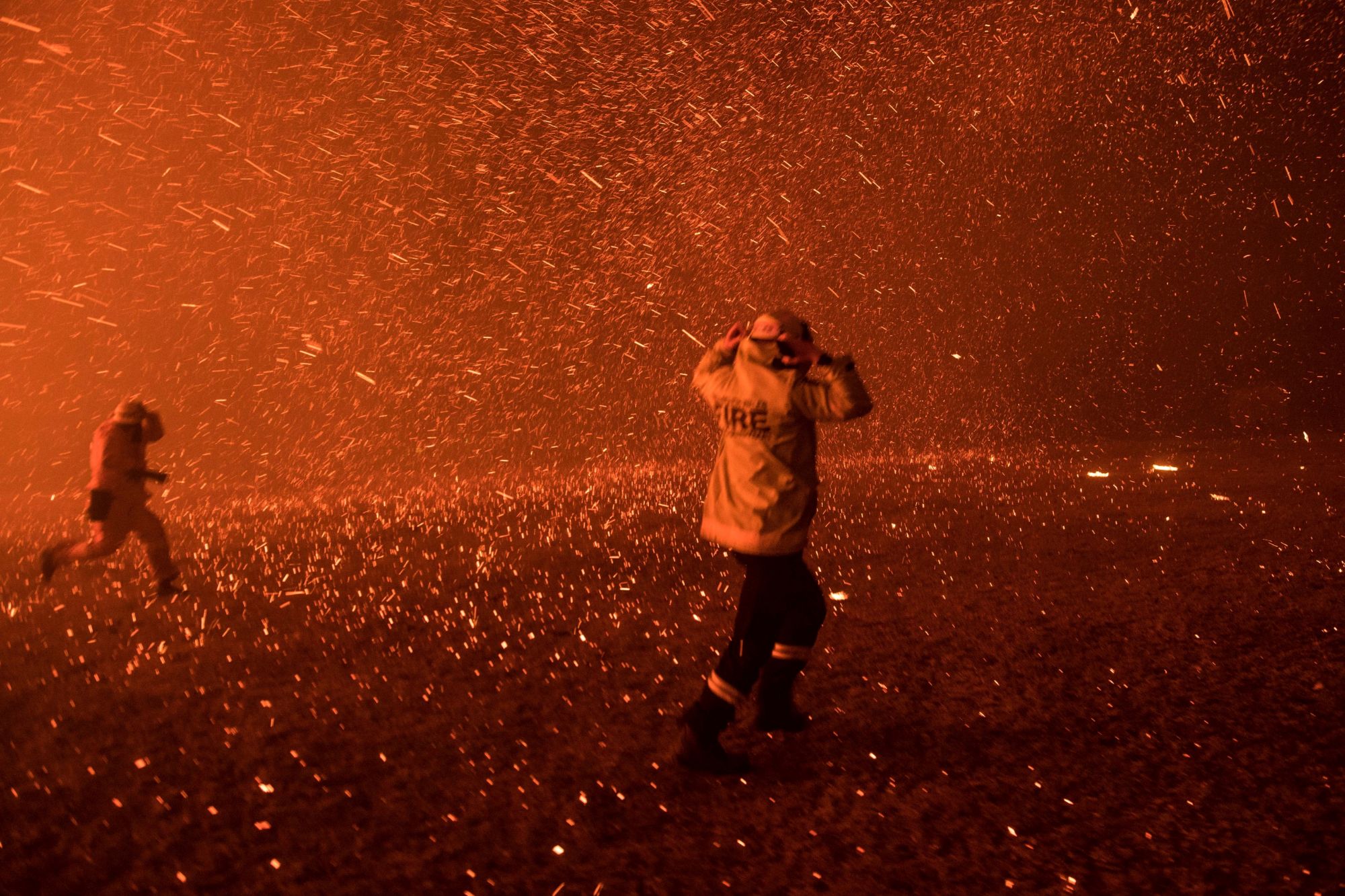The Walkley Foundation presents a digital photojournalism exhibition
It was the Black Summer – a summer of devastation and heartbreak that ravaged the eastern seaboard from the mountains to the sea, from south east Queensland, through the timbered coastal communities and hinterlands of New South Wales and into north eastern Victoria.
The flames turned their fiery breath on Tasmania and laid waste to more than half of South Australia’s iconic Kangaroo Island. In total more than 10 million hectares would be burnt out.
Old hands had feared this was coming. Long months, in some places years, of drought had sucked the last vestiges of moisture from forest and farm, coastal hamlet and urban fringe. The landscape was one vast tinderbox.
In remote country, searing winds fanned strikes from dry lightning, giving birth to the megafires – infernos of previously unmatched intensity.
The winds carried the stench of charred bush into the hearts of cities. Thousands sheltered where they could as fire ringed holiday destinations and choking smoke turned day to night.
Ordinary men and women, the firefighters of the Rural Fire Service, became the nation’s heroes. But alongside them worked the professional photographers, documenting the raw ferocity of the blazes, the bravery of those who battled them and the hope and heartbreak of communities in the path of the flames.
The work of these photojournalists took us into the heart of that epic battle, and their unforgettable images will forever inscribe on the nation’s memory what that time was like.
– Deborah Snow (@DeborahSnow), The Sydney Morning Herald (read “A summer of flame“)
“The summer Australia burned, 2019-2020” showcases the exceptional work produced by Australian photojournalists during the 2019-2020 bushfire season. The exhibition, curated by industry photo editors to represent a diversity of photographers, documents the scale of the tragedy and its impact on affected communities, as much as it captures the communal spirit and resolve that came out of the worst fires in recent Australian history.
– The Walkley Foundation
Exhibition curators and contributors: Mags King (SMH); Jeff Darmanin (The Daily Telegraph); Cassie Trotter (Getty Images); Moshe Rosenveig (Head On Photo Festival); Jessica Hromas (The Guardian).
Content warning: contains images that may be distressing to some viewers.
Nick Moir
The Sydney Morning Herald
The story behind the shot
“The Green Wattle Creek fire had burned for weeks in Kanangra-Boyd National Park, to the West of Nattai and Orangeville, slowly creeping closer and closer eastwards towards these communities. It got stuck for about four days on the western side of Lake Burragorang, a water source for Warragamba, but on the Thursday it managed to jump the water and raced straight through the bushland north of Nattai and Oakdale, heading into an area called Werombi and Orangeville. It didn’t destroy any homes on that first section, it just kept on winding its way essentially through where the most fuel was, which was some of the forested areas in the valleys.
“It started to quieten down around seven or eight o’clock, and myself and a couple of other photographers and some of the Fire and Rescue unit were at a house that was being defended in Orangeville. There was very little wind at surface level and a little bit over the top, and essentially this fire was slowly making its way through the bush.
“But ahead, it was really cooking the foliage, so the foliage was releasing a lot of its gases – flammable gases. It was keeping those gases held down because over the top was what’s called a thermocline – it was warmer above then it was down where the gases were.
“And then just as a weak southerly was moving through – it would have been about 8:30pm – suddenly this section about 300 metres long, about 50 metres deep, all just exploded. It all burned in about three seconds – so it was explosive.
“Suddenly this section all just exploded. It all burned in about three seconds… And then everyone just ran”
“And all of the firies had being, like, going, ‘Okay, get back, get back’. And then everyone just ran. One guy jumped in a truck and started to move the truck out. The rest of us were running and I was photographing the firies running and then just also the huge amount of flames. There’s a photo that is also in [the exhibition – image five] where you’ll see a single truck and then just massive flames all around it with a fire tornado on the left. That was at the same moment.
“And when all this erupted, it put millions of embers into the air, and the radiant heat was just astounding, which is why we were running. It was really difficult to photograph technically because it started off being quite dark and just a little bit of light from the fire, which was about 50 metres back in the forest, and then suddenly it all erupted.
“So you were getting right to the top end of being able to actually expose. It was getting almost too bright to actually expose for the cameras. And then it went back to about halfway between, when all the embers were out, so trying to keep in your mind that you wanted to have a shutter speed fast enough to capture people running and not have them blurred, but also capture the glow of all the embers.
“It was all very instinctual to try and capture that sort of stuff. I think that’s called an area ignition, which is kind of a boogeyman for firefighters. They don’t happen all that often, but they are very dangerous because they’re unpredictable. And almost…very unexpected when they occur, like you can literally go from nothing to maximum intensity in seconds.”
– Nick Moir
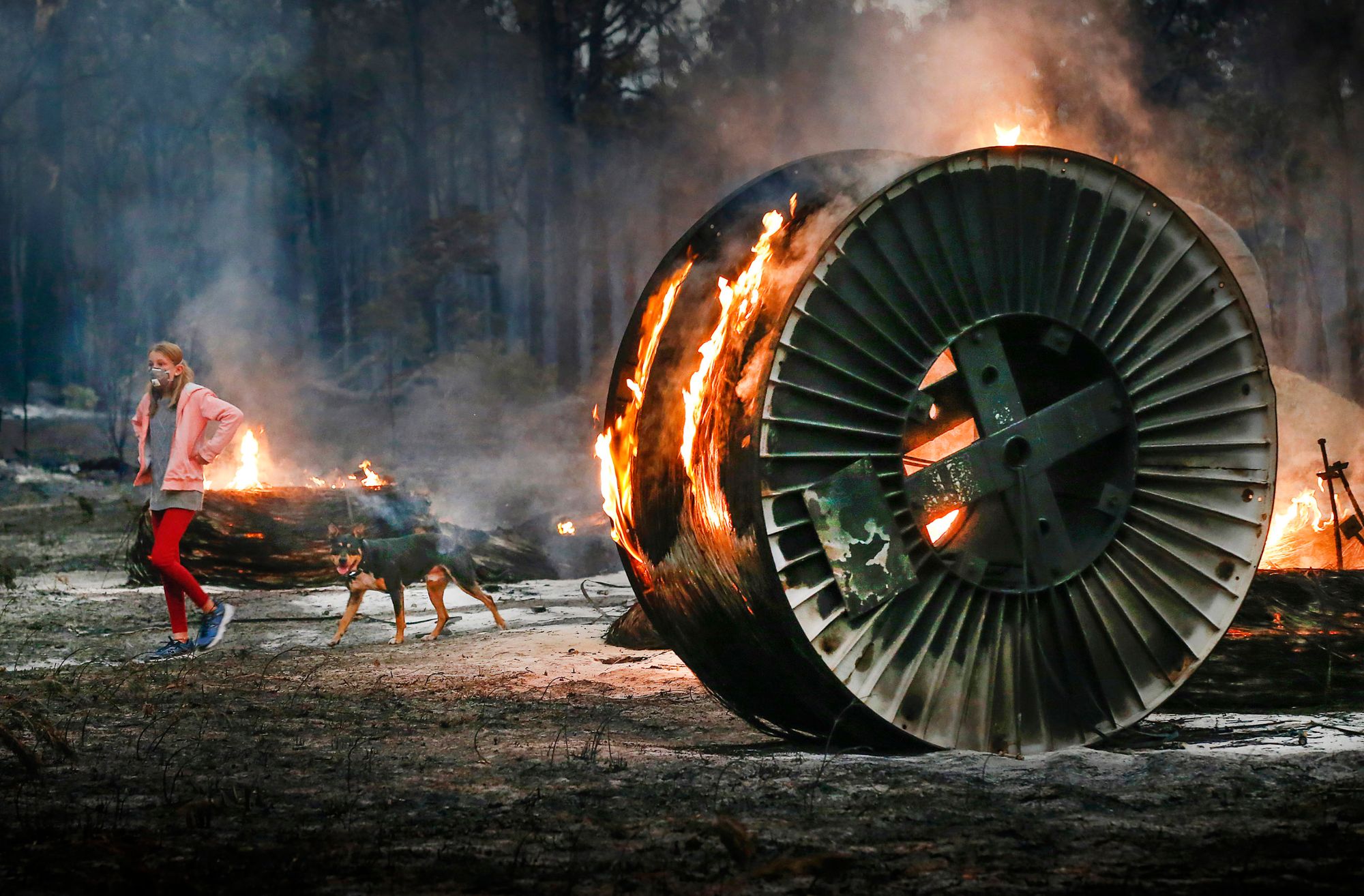
David Caird
Herald Sun
Title: “Alice in Horrorland”
East Gippsland fires, Mallacoota township. Destroyed homes in the township. Jessica Tregellas, 13, walks her dog past burning NBN cable spools along the scorched property.
The story behind the shot
“After filing my images of fire ravaged Mallacoota for deadline on the first day, I drove out of town looking for more when I came across a large property the fire had raced through, and spotted something quite surreal. A young girl was out walking her dog through the blackened field. A kid walking a dog wouldn’t get a second glance on an ordinary day, but with her immediate world blackened into an apocalyptic nightmare, this was no ordinary day.
“Jessica, 13, was dressed in a bright pink jacket and colourful leggings. All this colour on her, surrounded by all this black and grey and trauma, walking by large burning cable spools that resembled the flaming jet engines of a crashed airliner…I thought it looked like…not Alice In Wonderland but Alice in Horrorland.
“I took the photo and it became one of my favourites, as it just summed up how quickly the locals got on with life after the devastation.”
– David Caird
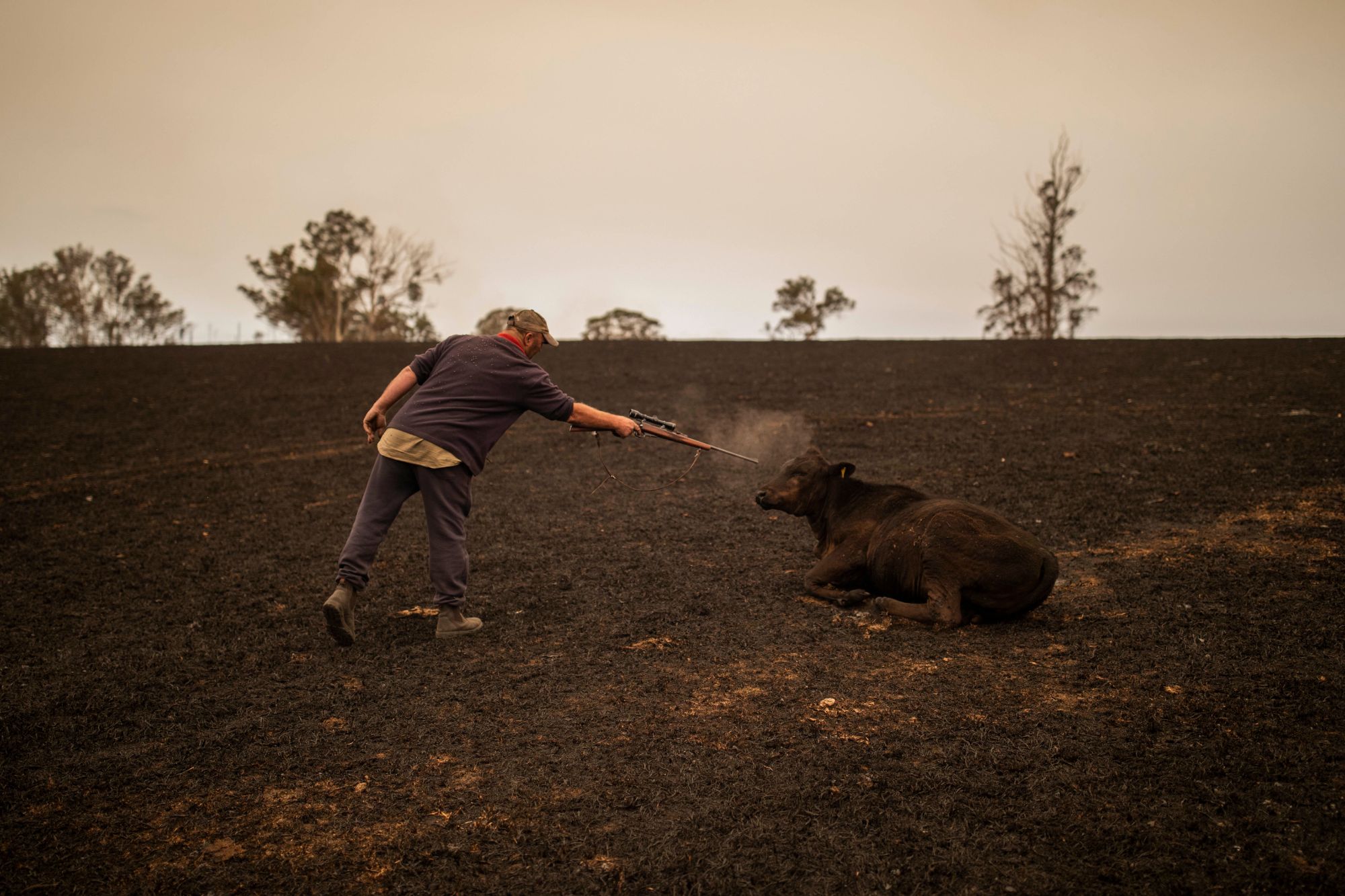
Sean Davey
AAP
Steve Shipton shoots an injured calf in his paddock in Coolagolite, NSW, January 1, 2020. Steve lost approximately 50 cows out of a herd of 200 in the bushfire on New Year’s Eve morning.
The story behind the shot
“On 31 December 2019 a ferocious fire ripped through Cobargo (and other towns) on the South Coast of NSW in Australia. In the fire’s path were many homes and small towns that now lie in ruins.
“I met Coolagolite farmer Steve Shipton on New Year’s Day 2020 as he was culling injured beef cattle that were so badly burned that they couldn’t get up, let alone survive. Many cows lay dead on the burned ground, but Steve – like many farmers – had the grueling task of culling a number of cows and calves that were still alive. His favourite heifer that he had for 13 years also died in the fire.
“Steve and his family lost roughly ten percent of their herd, with many heifers that died pregnant with unborn calves. I was working for AAP (Australian Associated Press) when I met Steve and photographed him culling one of the injured calves. The poor thing had dragged itself about ten metres, but when we came across it, it couldn’t move any further, and it had burns to its legs that went to the bone and joints.
“I started a GoFundMe campaign for Steve Shipton after making this photo. I know the photo was widely published, and I think one of the best things that came from this was promotion of the fundraiser. The amount raised to date is over $34,000.
“I know that a lot of people are hurting, many have lost homes and worst of all lives have been lost. Steve wouldn’t agree to crowdfunding for him, no one I’ve met here on the South Coast would, I imagine. In the words of people we have met who have lost everything, ‘there’s someone worse off than me.’
“Steve told me that each calf was worth anywhere from $700-$1000, plus the unborn calves that were yet to be born. That’s how I came up with the figure of $20,000, $1000 for each of the cows that Steve and his family lost.
“I’m sure that any money raised from this effort will be shared amongst the Coolagolite community. Of that I have no doubt. I know other people are suffering also, and that Steve isn’t special in any way compared to all his neighbours who I didn’t meet and who weren’t photographed. He will be the first to tell you.
“Today an old mate of Steve’s drove 700kms in a semi-trailer from Tocumwul in NSW with $10,000 of hay as a gift for the family. There is no water, no power, no reception and certainly no feed for the remaining cows that Steve has in Coolagolite. Not only has the community been affected badly by the fire, but they have also been battling the extreme drought that everyone in rural and regional Australia is facing. Steve said that he was proud that he had kept his herd so healthy during such tough times.
“This picture of Steve shooting his calf went around the world, and I’ve read many comments from people all over the world who have been moved by Steve’s plight, and that of all people affected by the bushfires”
“I’ve never started a crowdfunding campaign, but I decided that I should at least try. This picture of Steve shooting his calf went around the world from Australia to the USA, Europe and Asia and I’ve read many comments from people all over the world who have been moved by Steve’s plight, and that of all people affected by the bushfires. The man who donated $10,000 worth of hay today helped to inspire this campaign, as too did a man who accused me and a colleague of doing nothing to help but sell advertising space for newspapers. I can understand people’s grief and I don’t blame him for his attitude towards me, but maybe, just maybe, this might be something that will help the Coolagolite community in the coming days and weeks.”
– Sean Davey
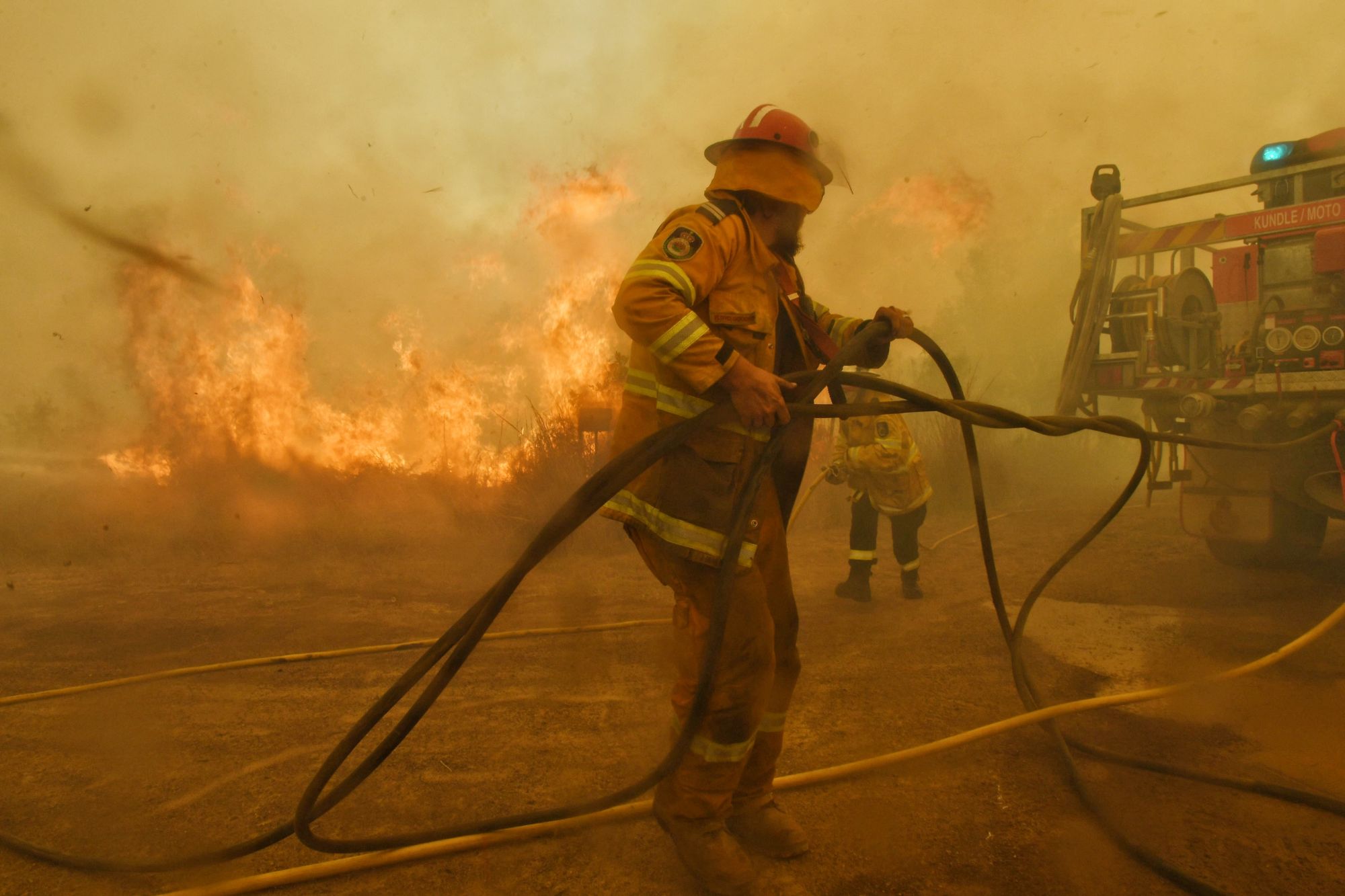 Nick Moir
Nick Moir
The Sydney Morning Herald
The story behind the shot
“This one was taken at the Hillville fire up near Taree, actually near the community of Hillville. Their fire had been burning for about a week, I think – it destroyed a number of homes to the east, and then under easterly winds it started burning westwards.
“Normally you would not see extreme fire behaviour on a moist easterly wind, but things were so dry that any sort of winds got the fire moving very rapidly. What has happened here was spot fires were starting to occur in the farms bordering the actual main fire. This one was racing up towards a farm and two local units raced in to try and block it, and they were still trying to get the hoses out as the fire burnt over. It’s called a ‘burnover’, where the fire comes through you. At that stage it was a grass fire rather than a forest fire, so it was survivable, but everyone just had to get down low and just try and handle the radiant heat and choking smoke as it went past.
“We all went down onto the road, so that frame is just as they’re scrambling to try and get the hoses out. You can see a person in the back starting to run, just as the shit really hit the fan. They did save the farm. So it’s five minutes of intensity and then racing around to try and intercept it again.
“It’s an adrenaline rush, certainly, while you’re covering it. But that season was exhausting and demoralising because of the massive damage both to property and lives, but also to the ecosystems that will never recover, and probably some species that are now extinct.
“It’s an adrenaline rush, certainly, while you’re covering it. But that season was exhausting and demoralising because of the massive damage both to property and lives, [and] the ecosystems that will never recover”
“That certainly was terrible to witness. At the time, I needed to have breaks because it was becoming quite depressing. But I’ll go back to doing fires again. I don’t know if I’ll see one of that level – as in, constantly that level. We’ll certainly see fires of that intensity again, but whether or not [we see] so many at once, that’ll be a little bit hard to back up… For single days I’ve been to some full-on fires, but not week-on-week-on-week-on-week-on-week.
“The devastation seen at ‘Black Saturday’ [2009], the destruction there was similar to what we saw here, but it’s the pure scale of how many fires of equal strength to the ‘Black Saturday’ fires we saw in New South Wales. There were many more. And we just kept on having them week-on-week-on-week. So it was exhausting both covering them on the day and also trying to predict which communities and which fires would be the ones that would erupt into full strength next.”
– Nick Moir
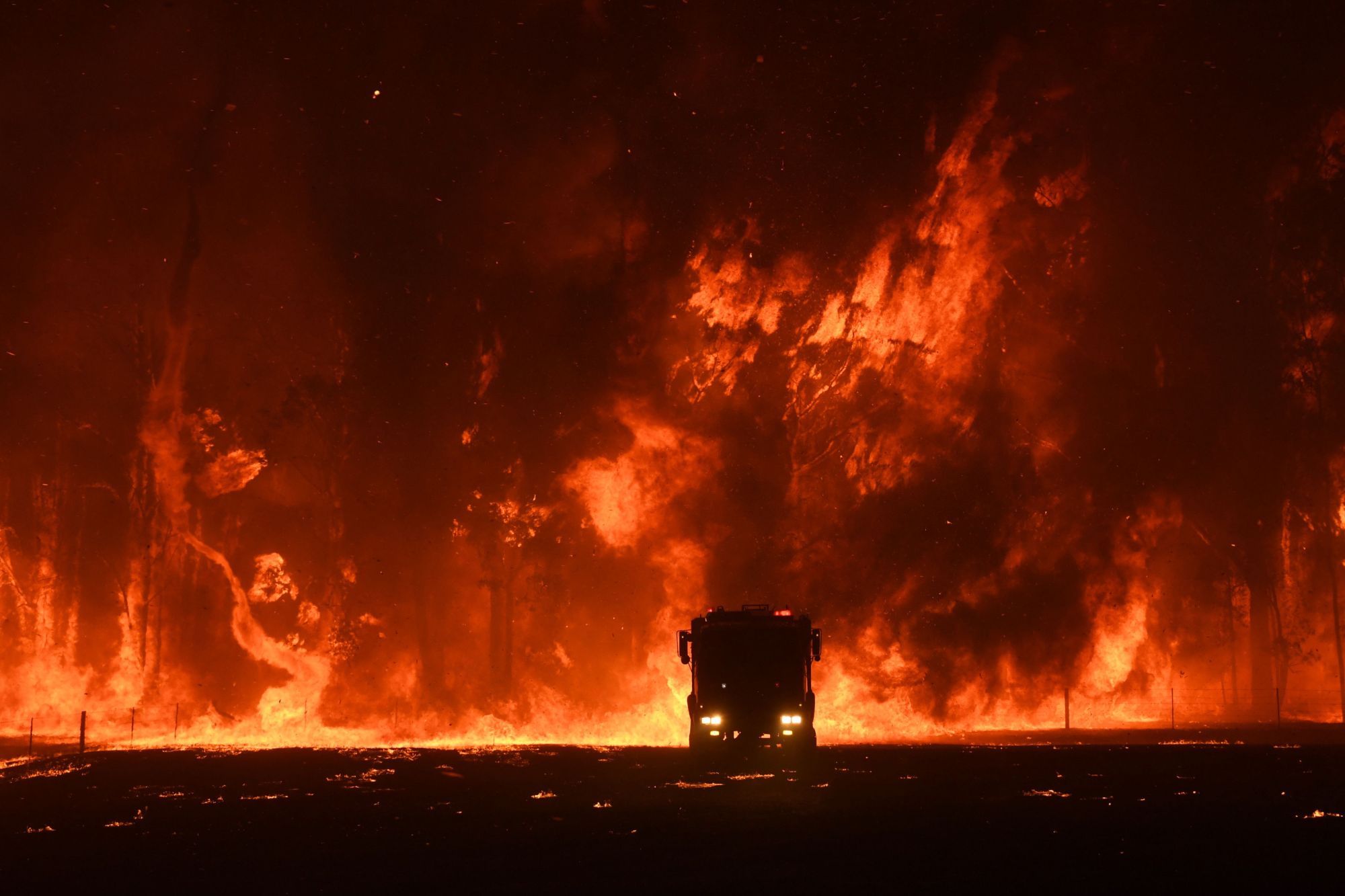
Nick Moir
The Sydney Morning Herald
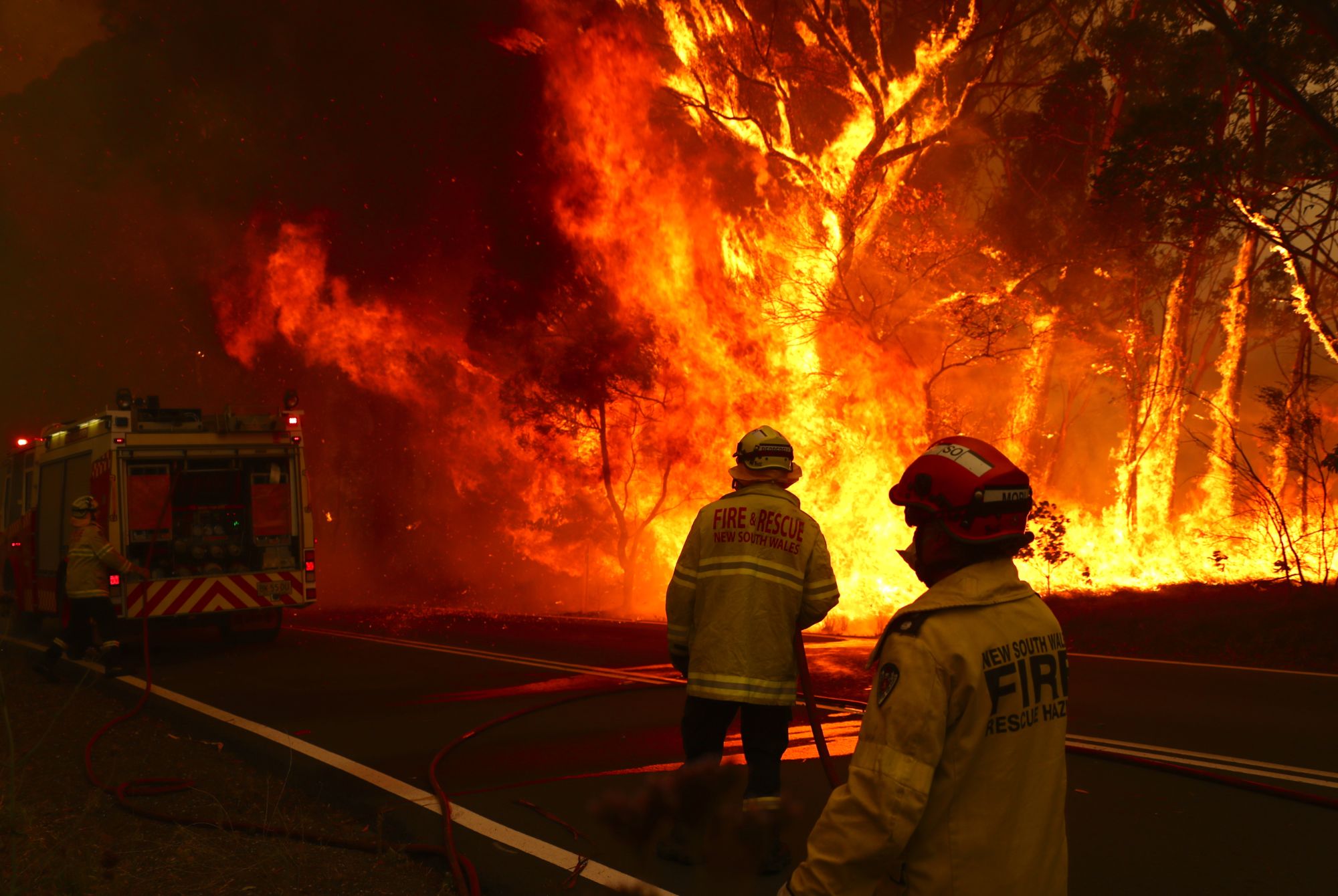 David Gray
David Gray
Getty Images
The story behind the shot
“This particular day started out extremely quietly. But the one thing I have learned about covering bushfires over the past three decades, is that you not only have to be patient, but you need to be alert to fast-changing situations. A few colleagues and I had been watching since early morning the smoke rising from the numerous fires burning around the township of Bilpin, located on the historic Bells Line of Road in the Blue Mountains.
“We noticed that the smoke was getting darker and much closer at around what’s usually the worst time of the day for weather conditions – around 2 to 3pm. After discussing access past a police roadblock, where one had not been just 10 minutes previously, we arrived at a fairly open area, where importantly there was more than one exit point. This is extremely important, especially if the fire becomes too dangerous.
“It didn’t take long for the firefront to be upon us. It swept quickly across a paddock, and then across the Bells Line of Road where we were positioned. During this time, I saw three fire-tornadoes – an indication of the intensity of the fire, and a sight I had only previously seen once in the past 30 years of covering bushfires. We decided that it had become too dangerous, so we drove up the road, away from where we thought the front had passed. We stopped and took some deep breaths.
“Without any exaggeration, the small flames became gigantic flames in less than ten seconds. The gum trees literally exploded, and the flames were now leaping over the roof of the firemen’s truck… It was all over in less than a minute”
“It was then that I discussed with colleague Nick Moir that we should walk up the road a bit and see if the firefighters had been able to save a house we had just driven past. We had not walked more than 50 metres when I noticed some flames visible behind a row of trees lining the main road, where a firetruck had just pulled up. Without any exaggeration, the small flames became gigantic flames in less than ten seconds. The gum trees literally exploded, and the flames were now leaping over the roof of the firemen’s truck. The firemen who were on the road seemed as surprised as we were, and helplessly looked on as a colleague scrambled to get inside the cabin and drive the truck away. It was all over in less than a minute, and thankfully, no one had been injured. Once we felt that the danger had finally passed, we quickly downloaded our images and sent them from our laptops on the bonnets of our cars.
“These situations again reminded me of the two most important things I have learned when covering bushfires: Always be alert, and always have an exit strategy.”
– David Gray
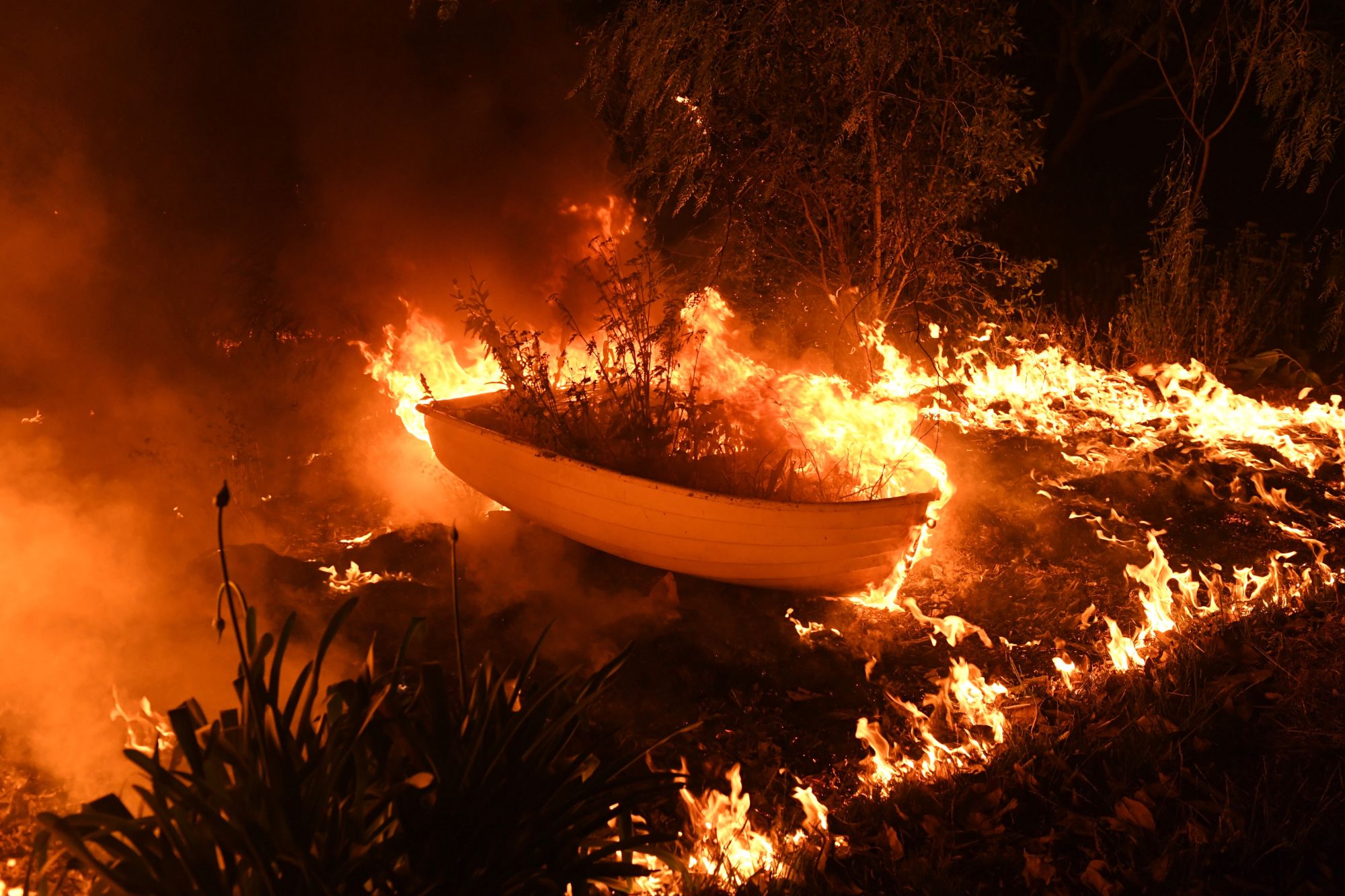 Nick Moir
Nick Moir
The Sydney Morning Herald
Hillville fire: A rowboat which had become a garden feature in the yard of a Failford home.
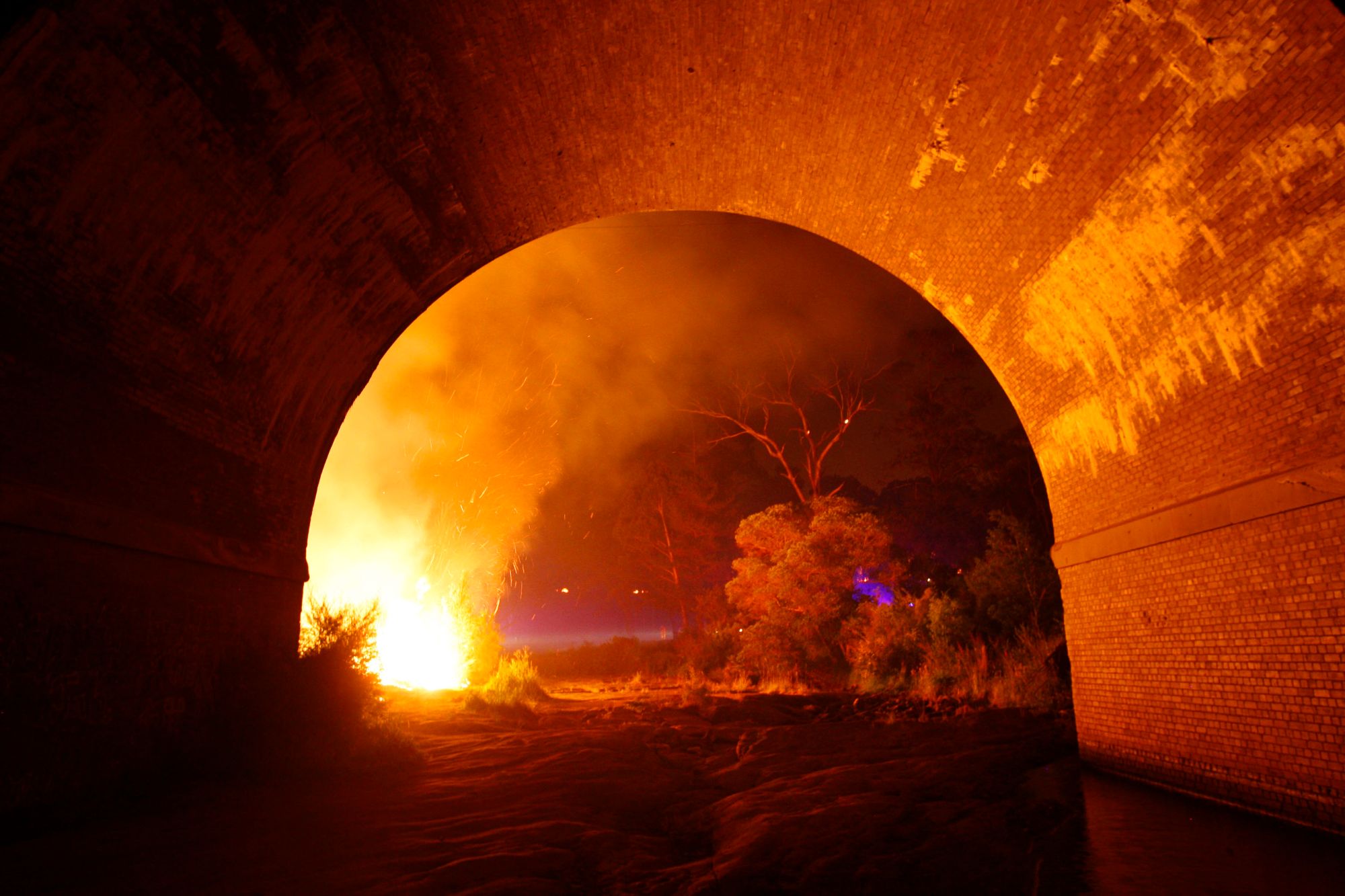
Dean Sewell
The Sydney Morning Herald
19 December 2019: the old train bridge at Bargo River.
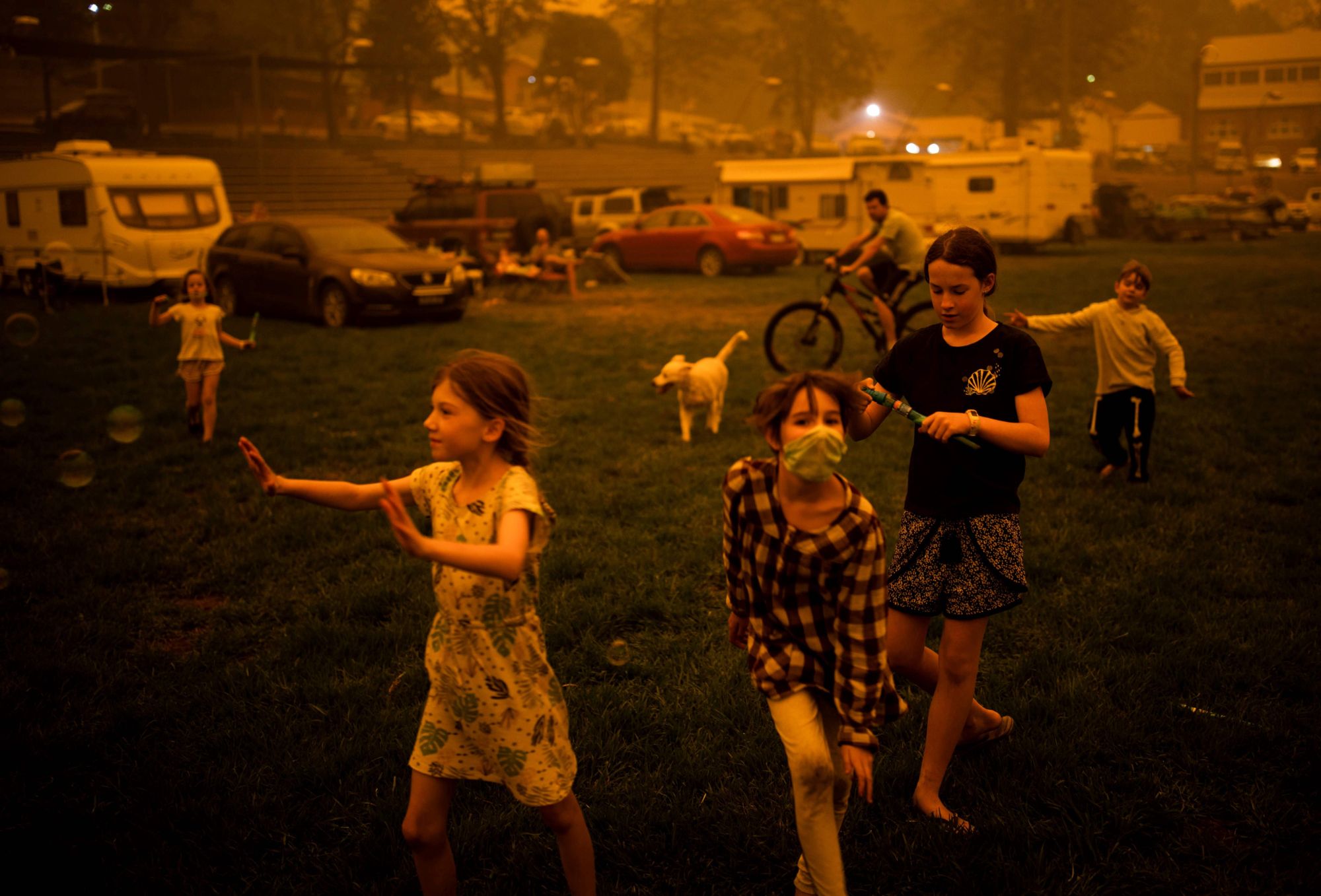
Sean Davey
AFP
Children play at the showgrounds in the southern New South Wales town of Bega where they are camping after being evacuated from nearby sites affected by bushfires on December 31, 2019. Thousands of holidaymakers and locals were forced to flee to beaches in fire-ravaged southeast Australia on December 31, as blazes ripped through popular tourist areas leaving no escape by land.
The story behind the shot
“On December 31 news spread that massive fires had impacted towns on the south coast of New South Wales. Living three hours away in Canberra, and with my car already prepared for covering the ongoing bushfire crisis, I made my way to Bega and arrived in the late afternoon. Many roads were closed due to the bushfire, and large parts of the south coast were completely cut off with no electricity, fuel or water. Even getting there was an arduous journey.
“Locals and tourists alike had been evacuated to the Bega Showgrounds for safety as the fires were still ongoing and there was great fear that other towns would be impacted. It would not be an exaggeration to say that the situation was chaotic. When I arrived I saw hundreds, if not over a thousand people camped with their tents and caravans set up. The smoke was thick, turning day to night with a strong orange glow. Many people wore face masks to protect themselves from the smoke and there was little to no access to information about what was happening. Many people were asking where I came from and how I got there, evidently weighing up how they could possibly get themselves and their families to safety.
“I saw a group of children playing in the middle of the showgrounds, and made my way to them. I approached a woman whose daughter was in the group, and asked how she was, identifying myself as a photographer. Her name was Kath Ferris and her daughter Abigail is the young girl in the face mask in the picture. Kath and her family were also from Canberra. They had evacuated to the showgrounds from a nearby campsite. They were on their way to visit family in a nearby town of Candello.
“The children appeared to be very happy, and in that microcosm, the gravity of the surrounding situation seemed suspended by their innocence. I knew there was a strong picture to be made”
“The children appeared to be very happy, and in that microcosm, the gravity of the surrounding situation seemed suspended by their innocence. I knew there was a strong picture to be made in this situation, and looking through the camera’s viewfinder, I saw the scene as a photograph, as well as being there in real life. When I get this feeling with photography, it is like a type of time travel, very surreal, and it is something that only happens very rarely. When I reviewed my pictures from that afternoon to send to the desk, I knew this picture would be the one, even though I sent two variations of the same scene. The surreal quality I felt when making the image is still there when I look at it today.”
– Sean Davey
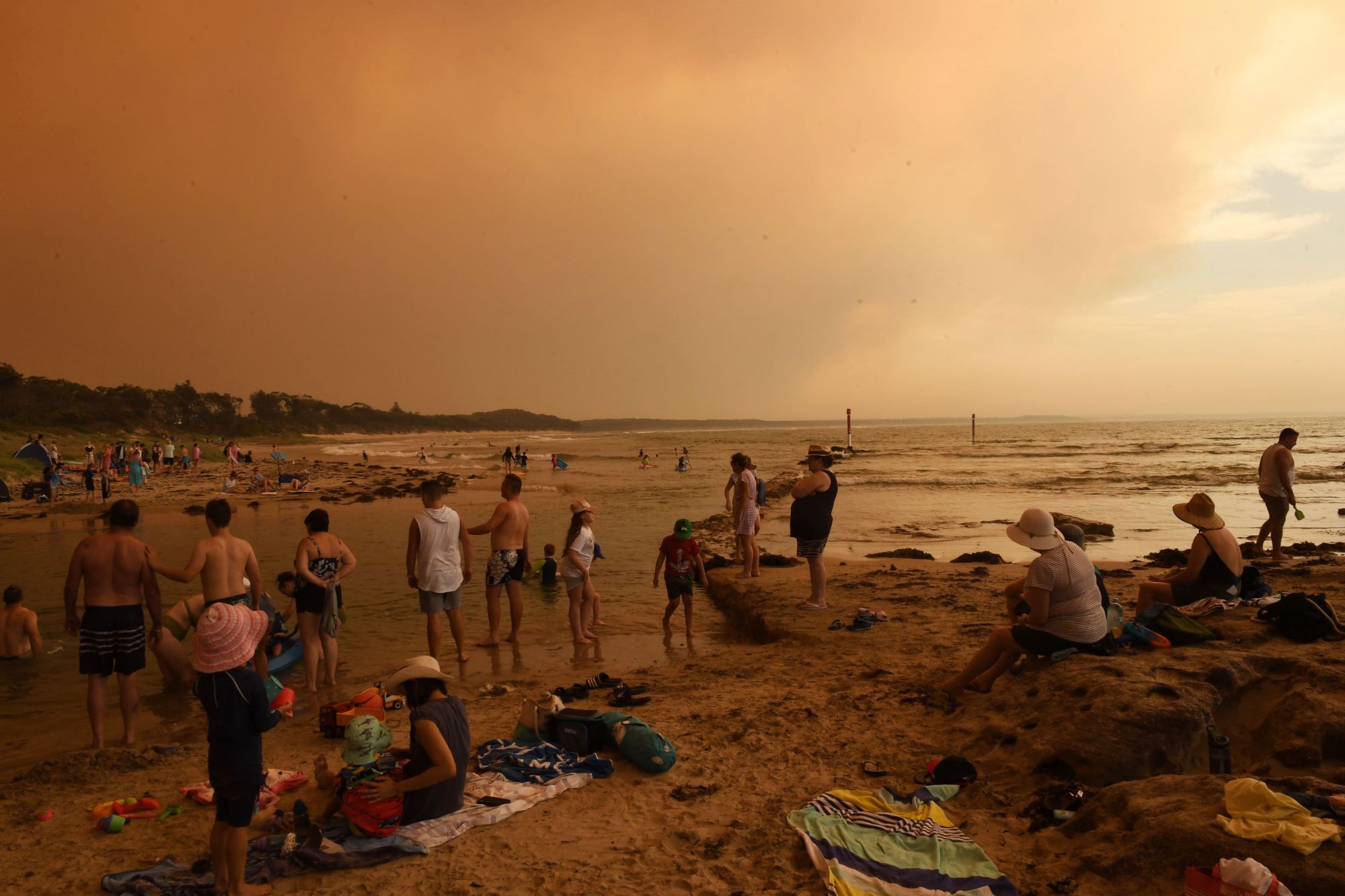 Nick Moir
Nick Moir
The Sydney Morning Herald
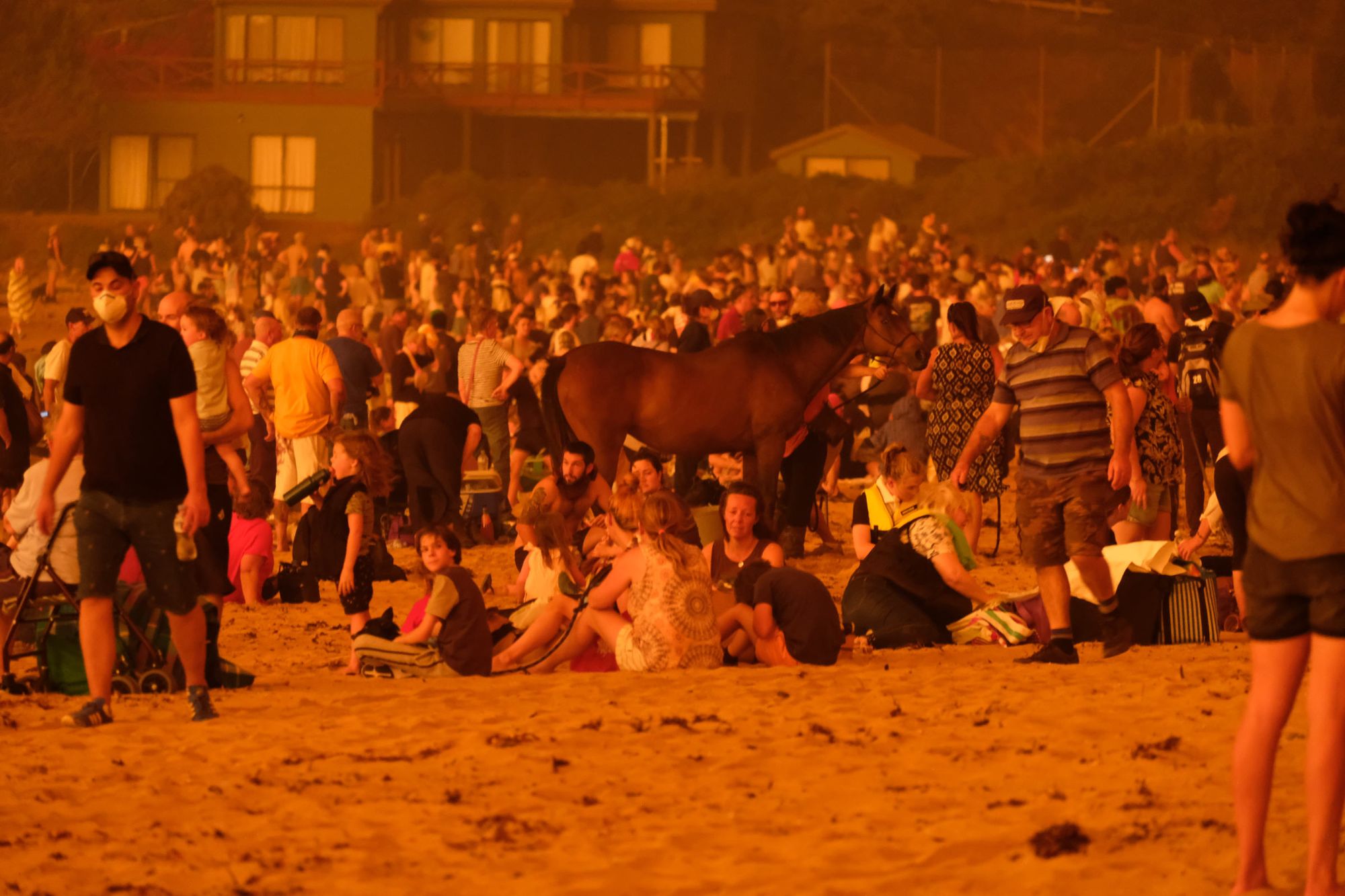 Alex Coppel
Alex Coppel
News Corp Australia
Bushfire arrives into the township of Malua Bay NSW, just south of Batemans Bay. Locals seek refuge on the beach as the fire approaches.
The story behind the shot
“Every year we go up to Malua Bay for the summer. Living in Melbourne, it takes us a good nine hours to get there and it’s quite an exciting time. We look forward to it every year… Leading up to New Year’s Eve, we were looking at the forecast and saw this day of high winds and heat that was coming, and we thought we’d better not be too inebriated on New Year’s Eve if we were going to protect ourselves. Luckily, all the fire came through quite early, as opposed to between 6 to 9pm when everybody would’ve been having a drink.
“I was at my parents’ house with the family and in between protecting that house and looking out for embers and standing on the roof and hosing, I would walk over to the hill where you can see straight down to the beach, and I could see thousands and thousands of people gathering on the beach. By the time I decided to go down to the beach, I could see the fire approaching the vicinity, so I grabbed the camera I had – which was fairly minimal, being on holidays – and rushed down to the beach. I spent all of, say, half an hour down on the beach because I was more worried about my house than I was about taking these images. But I knew at the same time that what I was seeing was just unprecedented and it needed to be documented, and I’m glad I did.
“I saw the headland was burning by this stage and there were people in the foreground, so I framed it where there’s a guy sitting there with his dog [see next image]. The surf had been huge leading up to this and I half-expected to see a surfer on the wave. Just as I took that photo, there was a perfect wave that came through and a guy just looking like he was giving in to the fact that the headland was burning all around him.
“Then I continued on to where surf lifesavers were yelling at everybody, ‘Get to the beach, get to the beach. It’s urgent’. They were doing really well. I did a full lap of the beach before the wind changed and that was when I got worried about our house. I knew that the embers would completely about-face and come back toward us.
“I sprinted back along the length of the beach to rush back to our place and that’s when I saw the horses, ponies, dogs… I basically had to stop running, take some pictures, and run again. I took all of these pictures in a really short time. I wish I’d spent longer down there, but I just didn’t want to live with myself if our house was burning by the time I got back to the top of the hill.
“The lady with the horse, she had to ride her horse down to the beach because it didn’t want to get into the float”
“Since then I’ve been contacted by all the people in those images asking me for copies because they knew that it was something worth documenting and keeping for themselves. The lady with the horse, she had to ride her horse down to the beach because it didn’t want to get into the float. There was another guy sitting there with his dog. They came from Bayhaven. People came from all these different areas and sought shelter in Malua Bay from the fires. I think several homes were lost, but luckily there were no lives lost in the area.”
– Alex Coppel
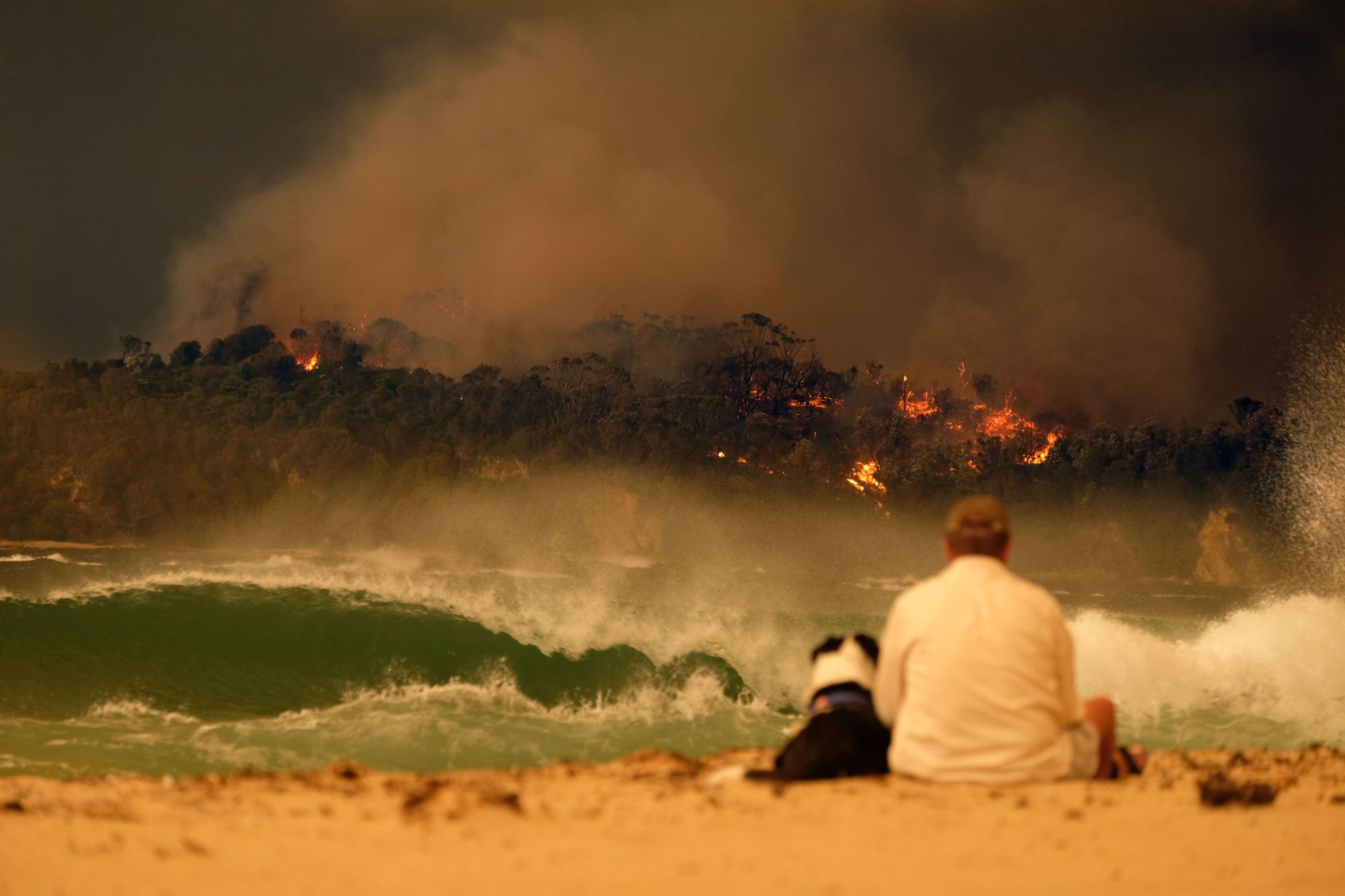
Alex Coppel
News Corp Australia
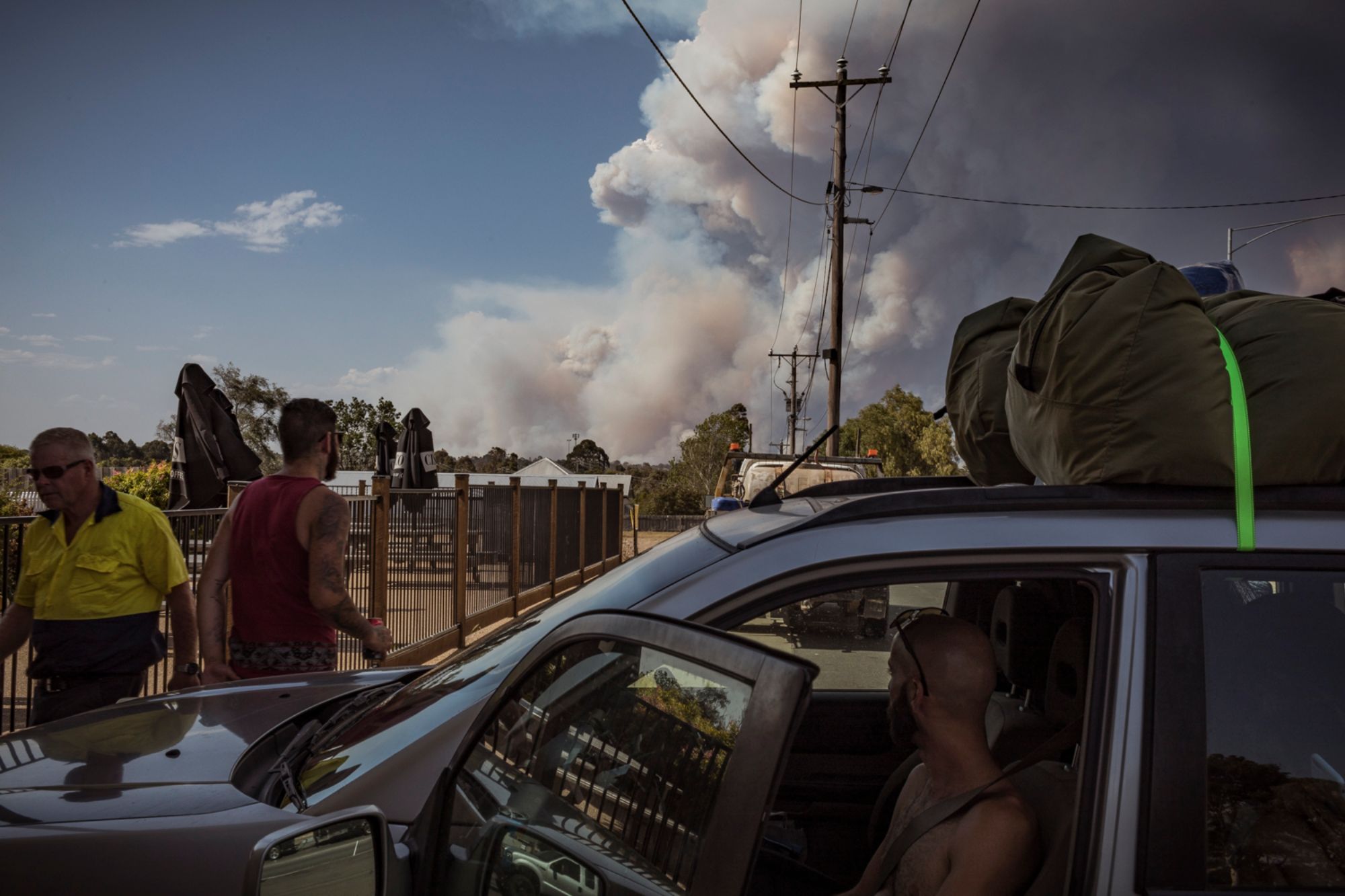 Chris Hopkins
Chris Hopkins
The Guardian
The story behind the shot
“I was on assignment with Calla Wahlquist for The Guardian in Bairnsdale on December 30 and we had spent the day talking to locals who had heeded warnings to leave ahead of the predicted danger. We were just about to head off when we saw a small cloud of smoke erupt into this huge mushroom. It was rolling towards Bairnsdale at a rapid rate, rolling over itself engulfing the horizon. A carload of backpackers pulled into the milkbar we were at and wanted to head to a campsite which was, at that time, engulfed. The fire would within an hour or two raze the township of Sarsfield.”
– Chris Hopkins
 Chris Hopkins
Chris Hopkins
The Guardian
“I was on assignment for The Guardian on January 4, the day when the East Gippsland fires were expected to spike, and the three main fires in the region were to join together to create the mega fire we had been hearing about. The region was understandably tense. The small township of Bruthen had managed to be spared from the fire that tore through Sarsfield a week earlier but was flanked by two fires to its east and west at this point. In mid afternoon the Omeo fire to its north flared up and the wind change pushed smoke south and west blanketing the sky and turning day into a rust coloured night. The township was empty and eerie. The desperation from residents is evident here, and understandable, as the relentlessness of the bushfires and the ever-present danger that summer frayed nerves and created an unprecedented statewide anxiety.”
– Chris Hopkins
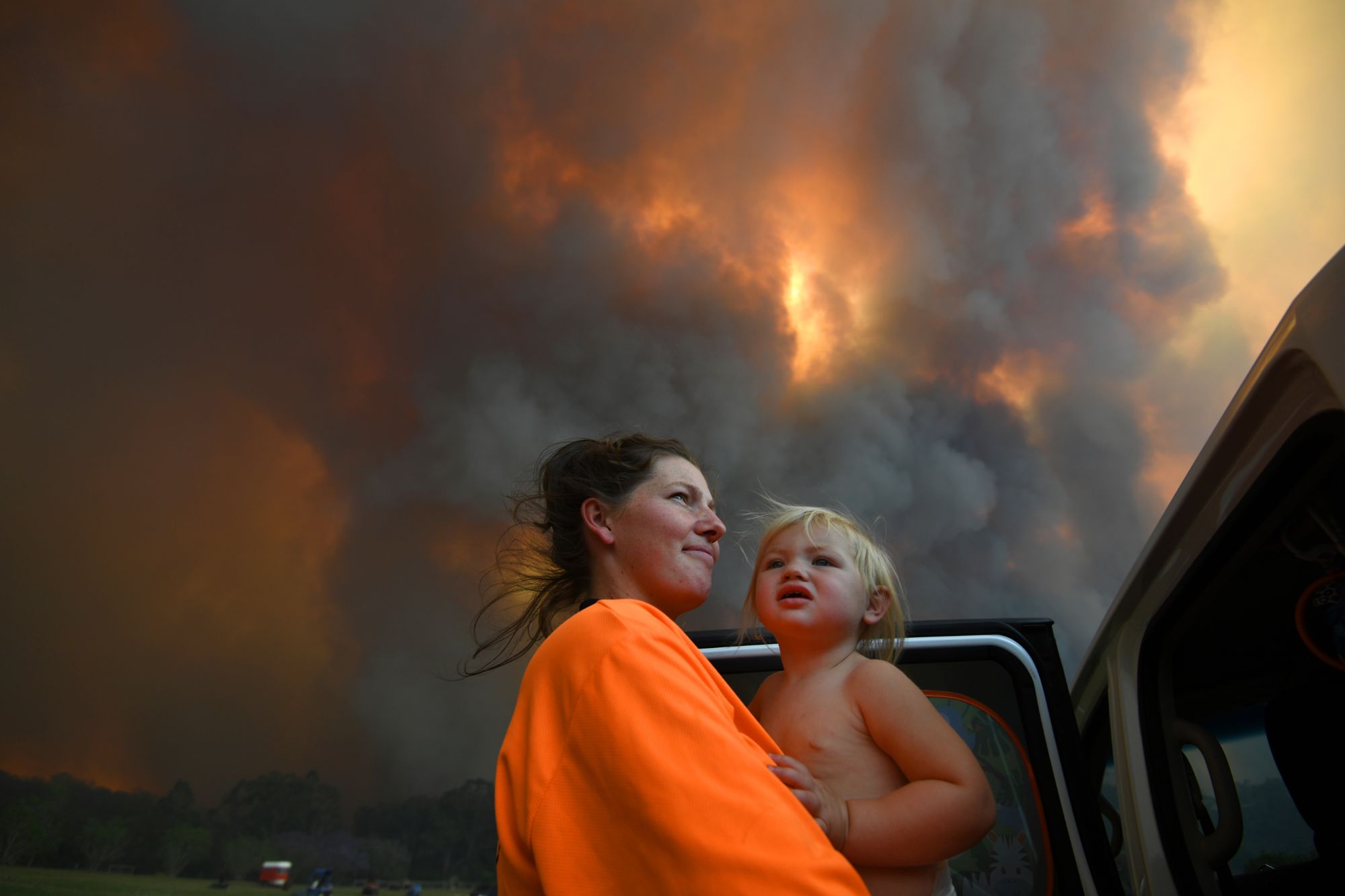 Dan Peled
Dan Peled
AAP
Sharnie Moren and her 18-month-old daughter Charlotte look on as thick smoke rises from bushfires by Nana Glen near Coffs Harbour on Tuesday November 12, 2019.
The story behind the shot
“It was towards the end of a long day chasing fires around Nana Glen, inland from Coffs Harbour. We stood there, a handful of media and a few locals, watching this huge fire front coming over the hill, about 500m from homes. A sudden wind change generated spot fires and it became too dangerous to stay. Sharnie Moran and her daughter Charlotte were making their exit too, seconds after I took their picture. A short time later the road we were on was surrounded by flames from both sides and shrouded by heavy smoke.”
– Dan Peled
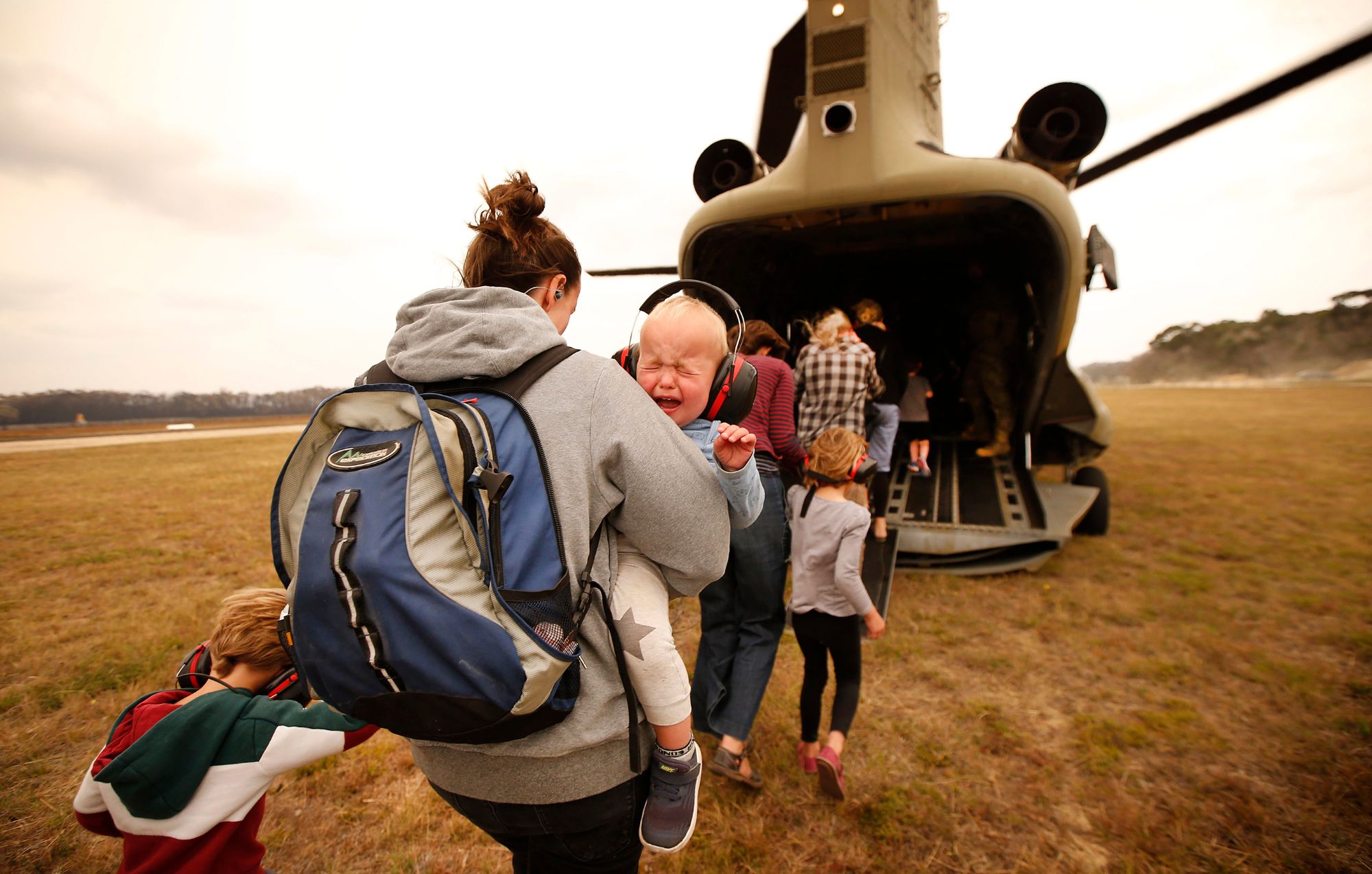
David Caird
Herald Sun
Title: “Exercise – Evacuation Mallacoota”
Last of the remaining evacuees are airlifted out of Mallacoota Airport by ADF Chinook helicopters. A baby in mum’s arms cries as they approach the noise and heat from the turbine engines of the running Chinook helicopter bound for Sale.
The story behind the shot
“With no roads likely to be passable for weeks, the Australian Defence Forces banded together to create Australian history by evacuating thousands of stranded people from Mallacoota by air and sea… Starting at 7am, I photographed the first wave of families – akin to refugees being rescued from a war-torn region – being checked off, briefed about the journey at sea, then carefully loaded into boats and amphibious troop carriers with military precision.
“I stood back to capture wide-eyed fretting children wearing smoke masks, clinging tightly to their mother’s hands, some excited while others cuddled their dogs for comfort, as the process of moving most of the township from land to sea continued throughout the day.
“The next day at the town’s airport, Army Chinook helicopters loaded families with young children and the frail aboard the iconic twin rotor heavy lifters. With noise levels behind the jet engines at above 120 decibels, hearing protection was needed. Following a group of families out to the waiting helicopters, I spied a rather relaxed baby in the arms of its mother waiting to board. That changed quickly to crying when the heat and noise from the jet blast hit home while walking into the open cargo door, giving me some great photos that reminded me of the Vietnam War helicopter evacuation of Saigon.”
– David Caird
 Justin McManus
Justin McManus
The Age
Title: “Military Evacuation of Mallacoota”
Mallacoota fires. People stranded in Mallacoota, after the bushfires that ravaged the town on December 30, are evacuated by army personnel to the HMAS Choules.
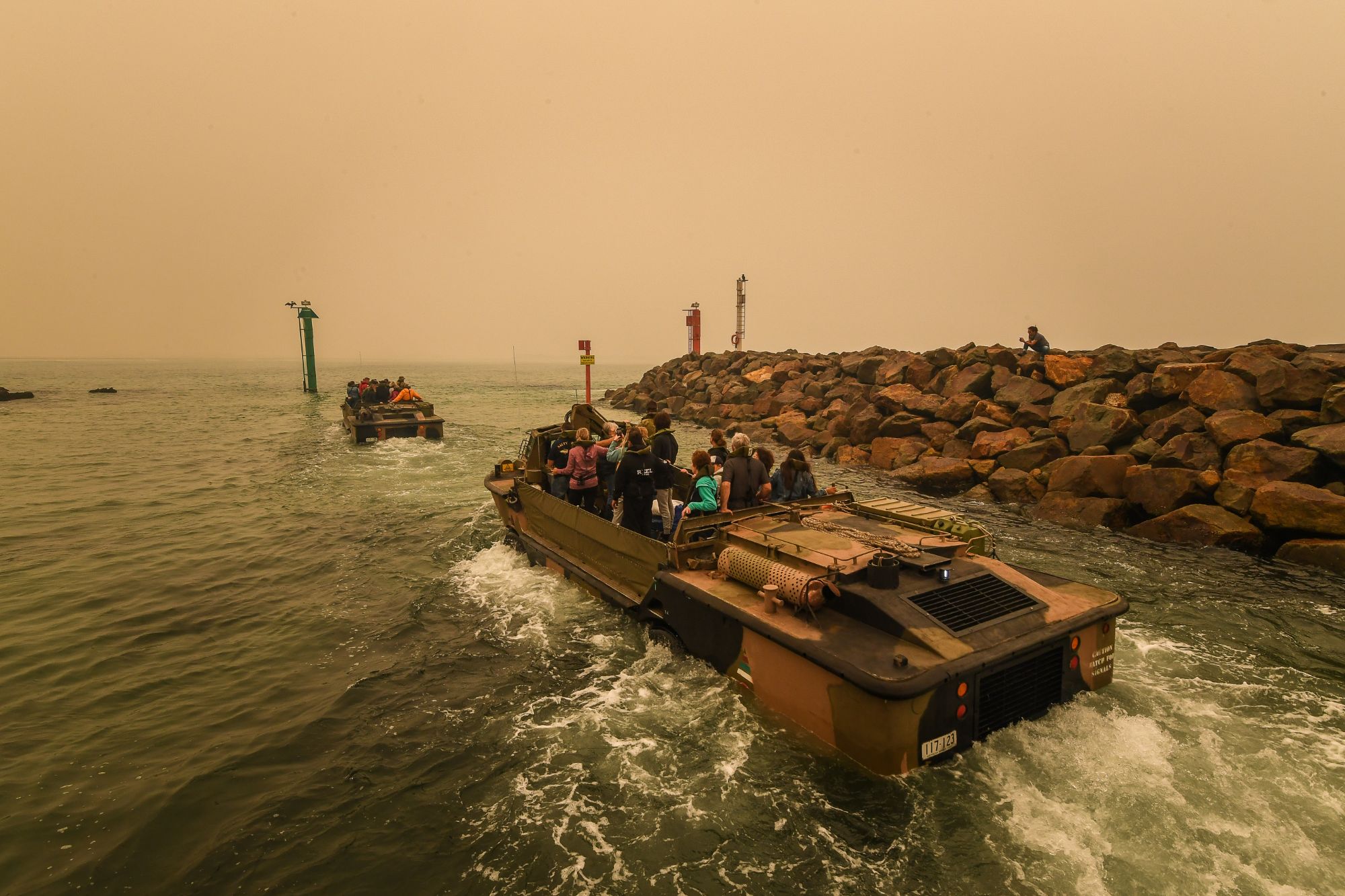
Justin McManus
The Age
Title: “Military Evacuation of Mallacoota”
Mallacoota fires. People stranded in Mallacoota, after the bushfires that ravaged the town on December 30, are evacuated by army personnel to the HMAS Choules.
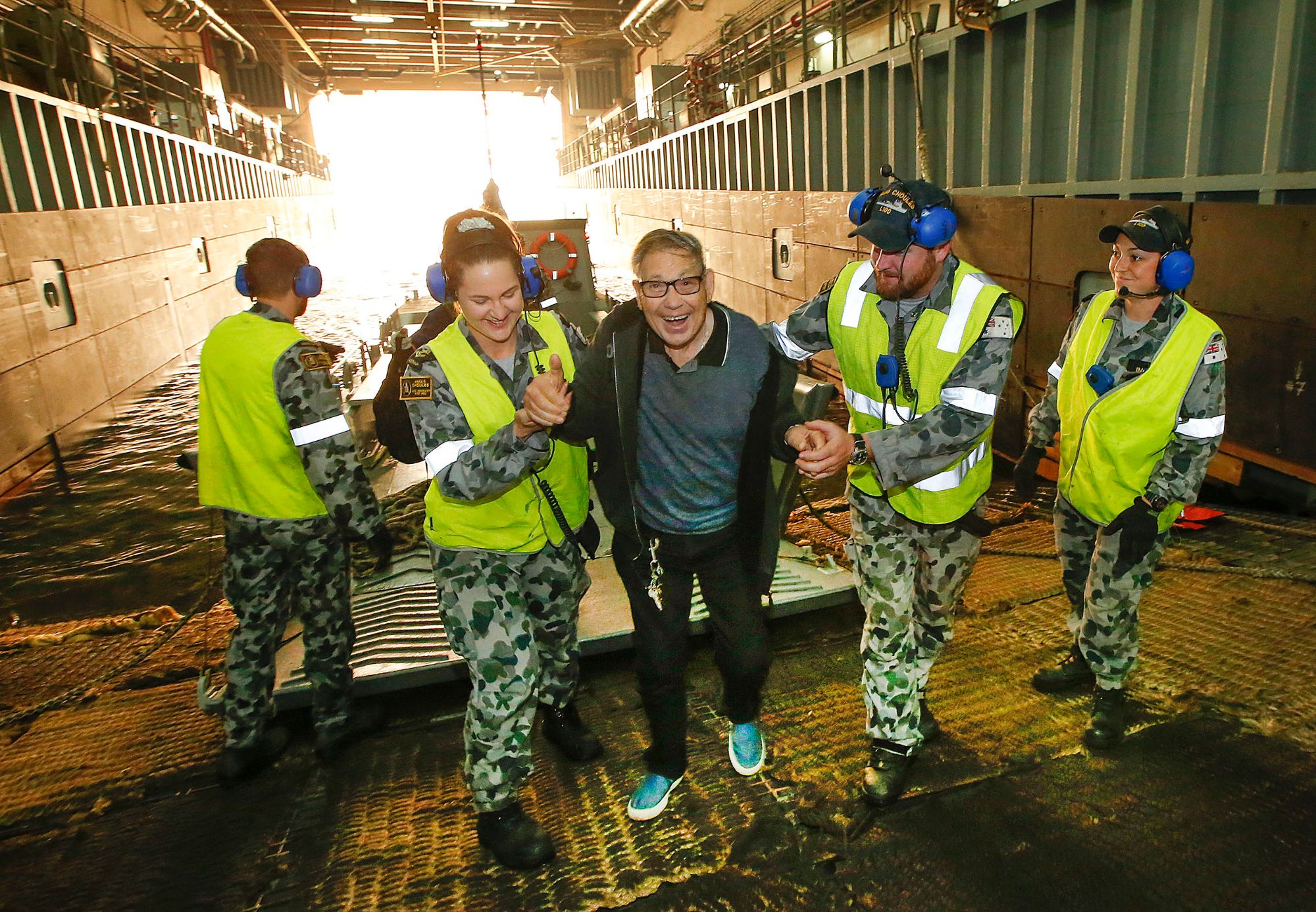
David Caird
Herald Sun
On board the HMAS Choules, it’s all smiles and laughter as a boat load of evacuees leaves Mallacoota for HMAS Choules.
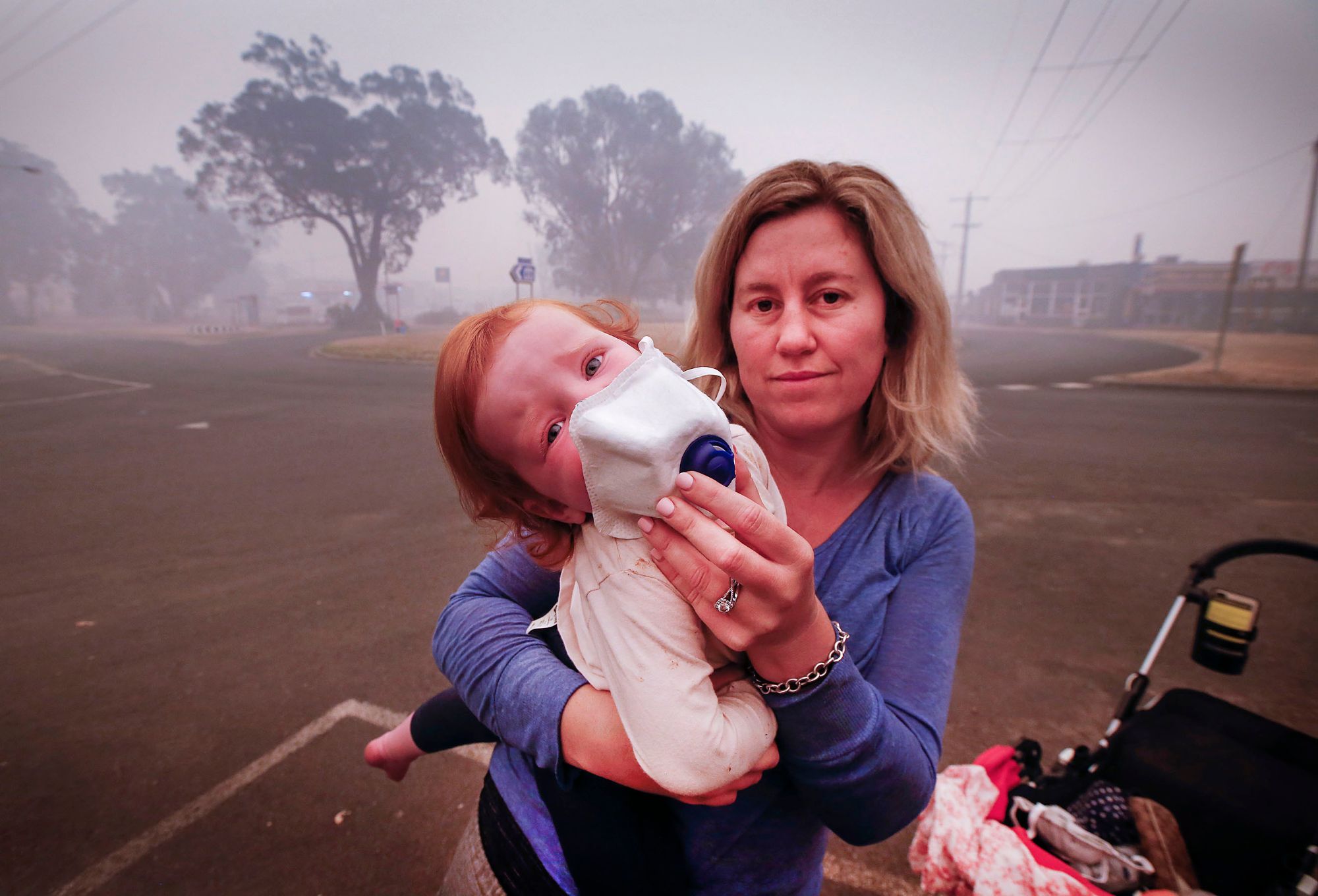
David Caird
Herald Sun
Title: “Baby this smoke sucks”
The story behind the shot
“Many of the children holidaying in Mallacoota were having trouble with the thick acrid smoke that had settled over the town since the start of the fires. I spotted a young mother, Laura Langmead, desperately searching for a facemask for her one-year-old daughter Evie. I had just put on my mask to deal with the relentless pungent smoke when Laura approached me asking where she could get one. The town’s chemist had run out and supplies had not yet arrived, so I gave her my mask for the child.
“This was just the opportunity I was looking for to illustrate the next problem facing the trapped children and elderly of the town. I asked for permission to photograph her trying to get the mask on the reluctant infant to filter the smoke from her lungs. The desperate emotion in the child’s eyes and on the mother’s face summed up the plight of the stranded peoples’ next phase after the flames.”
– David Caird
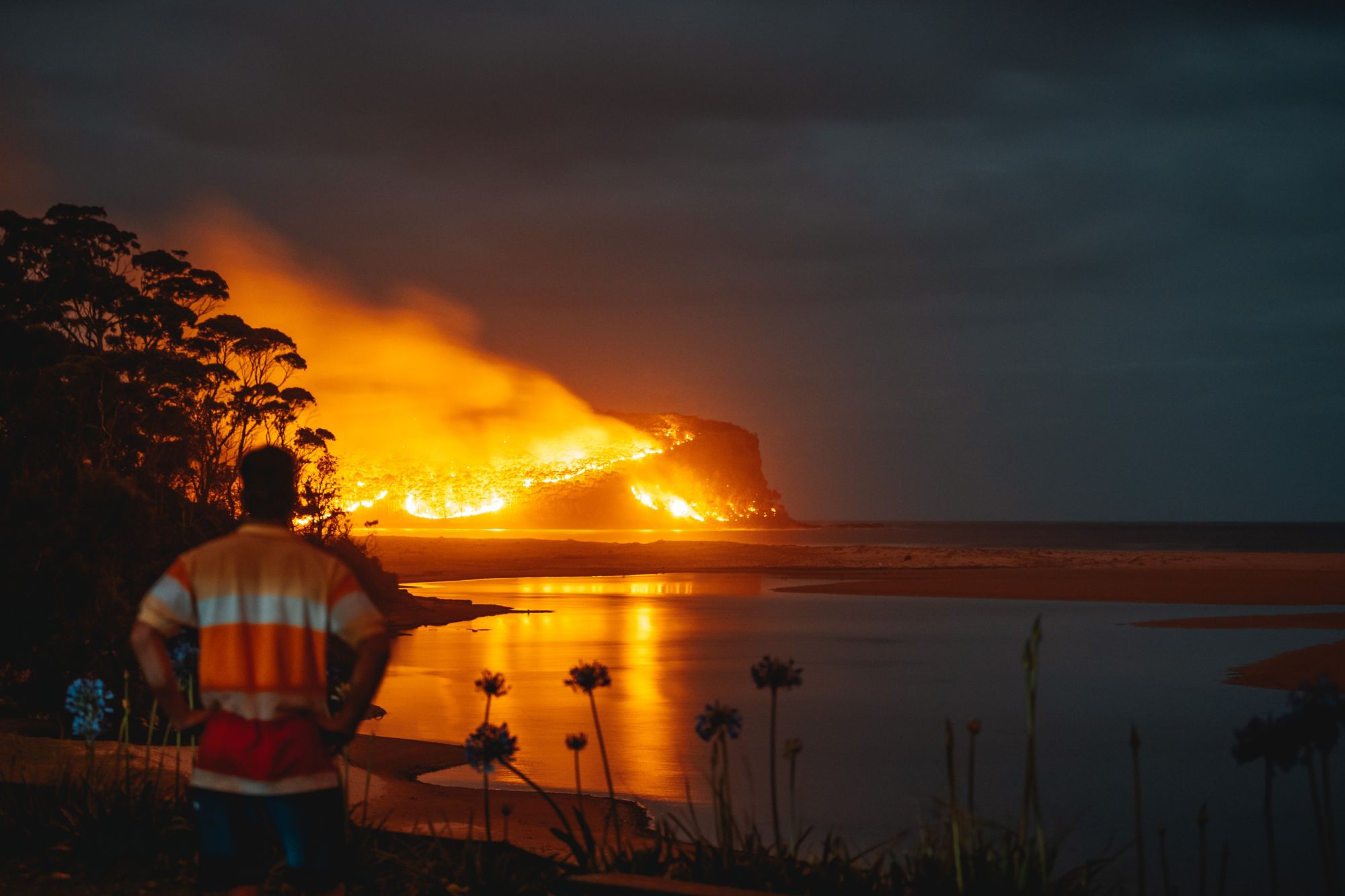 Josh Burkinshaw
Josh Burkinshaw
Sunday Telegraph
The story behind the shot
“I was with one of my best mates and his dad helping protect their property and once night set this is what we could see. There’s a weird sense of beauty amongst all this devastation.”
– Josh Burkinshaw
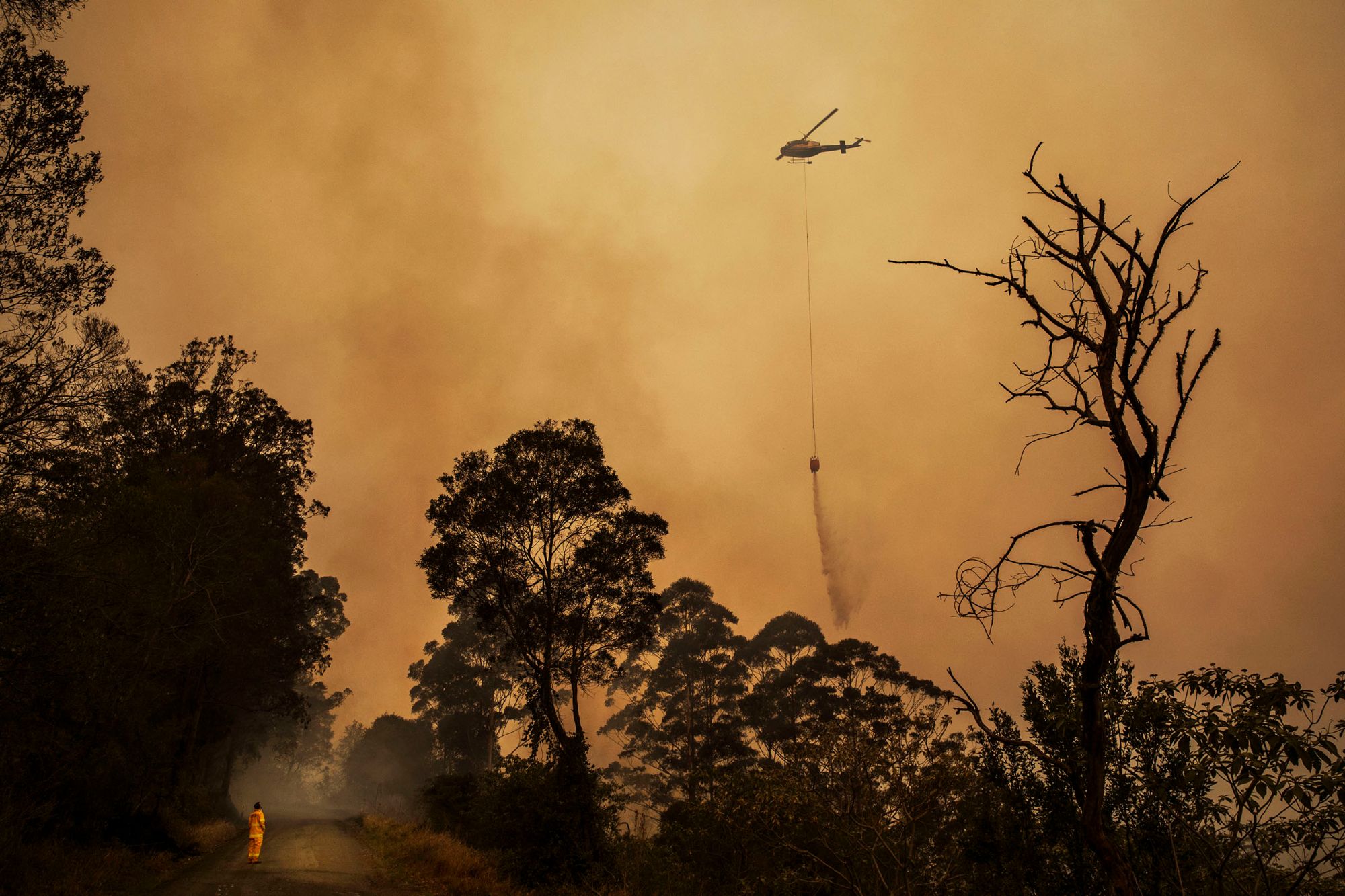 Jessica Hromas
Jessica Hromas
The Guardian

Kiki Sjöberg
Head On Photo Festival
Title: “The Monaro or Mars”
The story behind the shot
“This image was taken around the Dalgety area and I think it’s farming field; a cattle field. It was about 3:30 in the afternoon and the sky went black and then this dark red light that’s difficult to describe if you haven’t experienced it, especially in the afternoon when it’s supposed to be sunny. I got out of the car and walked around and there was no one on the roads. It was just this eerie, apocalyptic feeling. I looked at that landscape and…it didn’t feel like it was Earth, it felt like I was on Mars or somewhere else.
“It was getting pretty difficult to breathe around that time. Eyes were stinging from the smoke and it was just very apocalyptic feeling. Didn’t see a blue sky for weeks. It was just smoke and red… I still find it almost difficult to look at the images even though we were safe and saved. It’s still kind of a traumatic experience which I hope we don’t have to see ever again. With the images, it was just this terrifying beauty because in the middle of all that terror and fear it was still quite beautiful. It was beautiful light in a way, which sounds strange to say because of what might happen, but it was still… terrifying beauty.”
– Kiki Sjöberg

Kiki Sjöberg
Head On Photo Festival
Title: “Red Dawn Deer”
The story behind the shot
“I was living in Crackenback, a part of the Snowy Mountains just outside Jindabyne. The fires had been progressively getting worse over the New Year period and when we woke up that morning it was just a blanket of red smoke, a bit difficult to breathe and see. There was just an extremely eerie feeling in the air. I think all the animals were acting weird, this deer was just kind of standing there looking a bit confused. Usually there’s about 20 or 30 deer around and he was just standing there alone.”
– Kiki Sjöberg
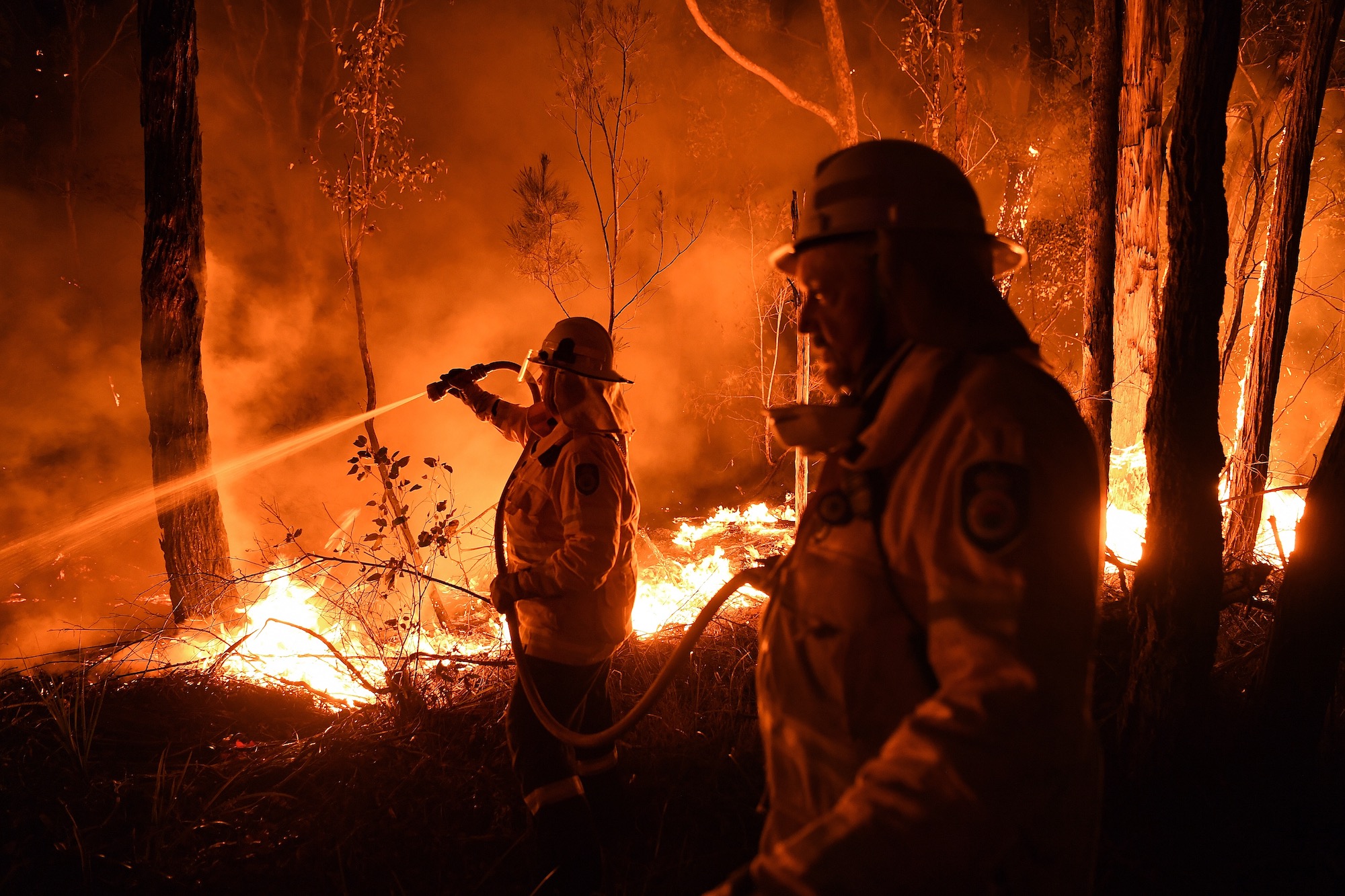 Kate Geraghty
Kate Geraghty
The Sydney Morning Herald
NSW RFS firefighters work through the night to prevent a flare up from crossing the Kings Highway in between Nelligen and Batemans Bay, January 2, 2020.
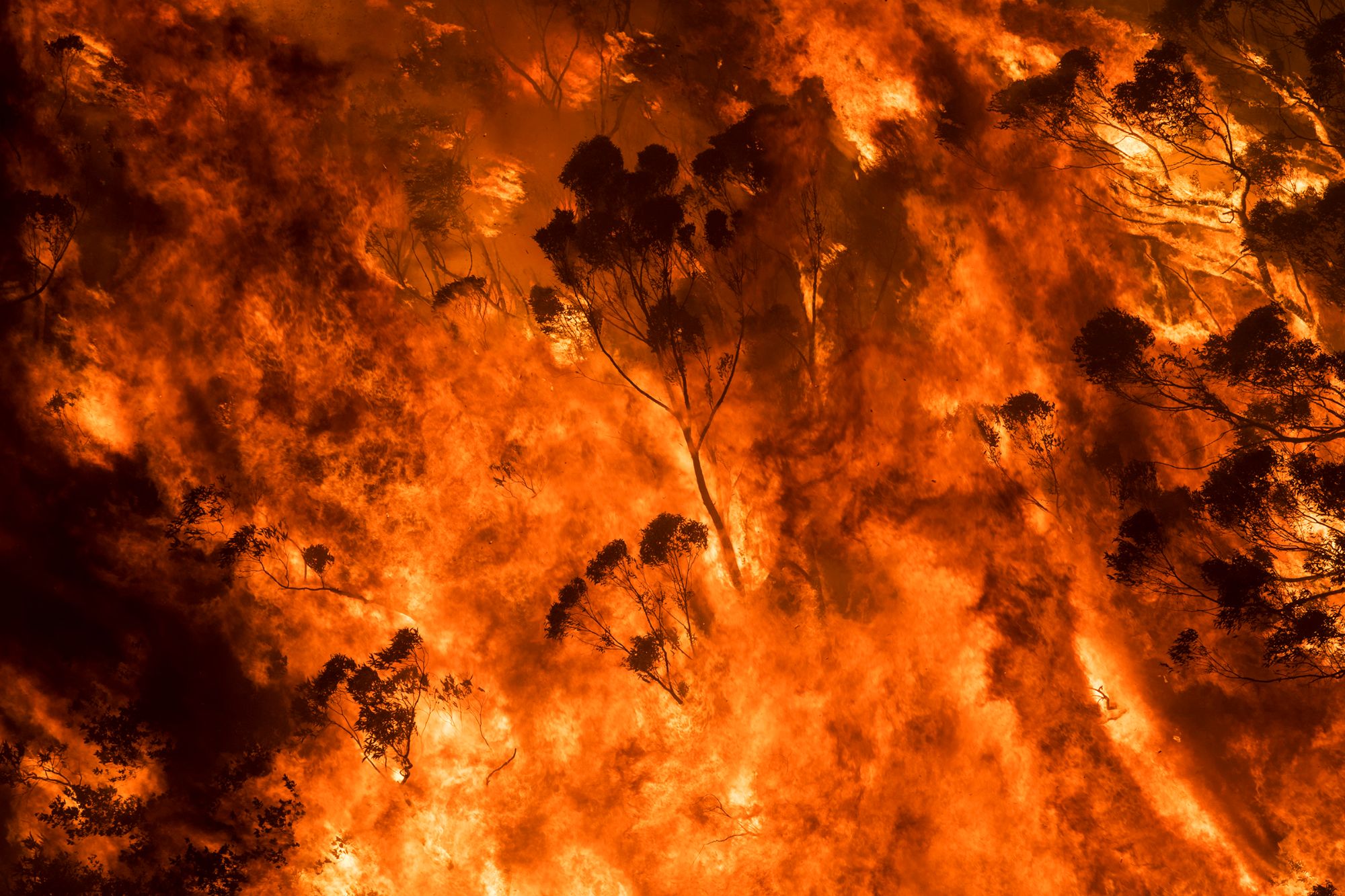
Nick Moir
The Sydney Morning Herald
The fury of the Gospers Mountain fire, which burned for months in the Wollemi and Yengo National Parks in Australia.
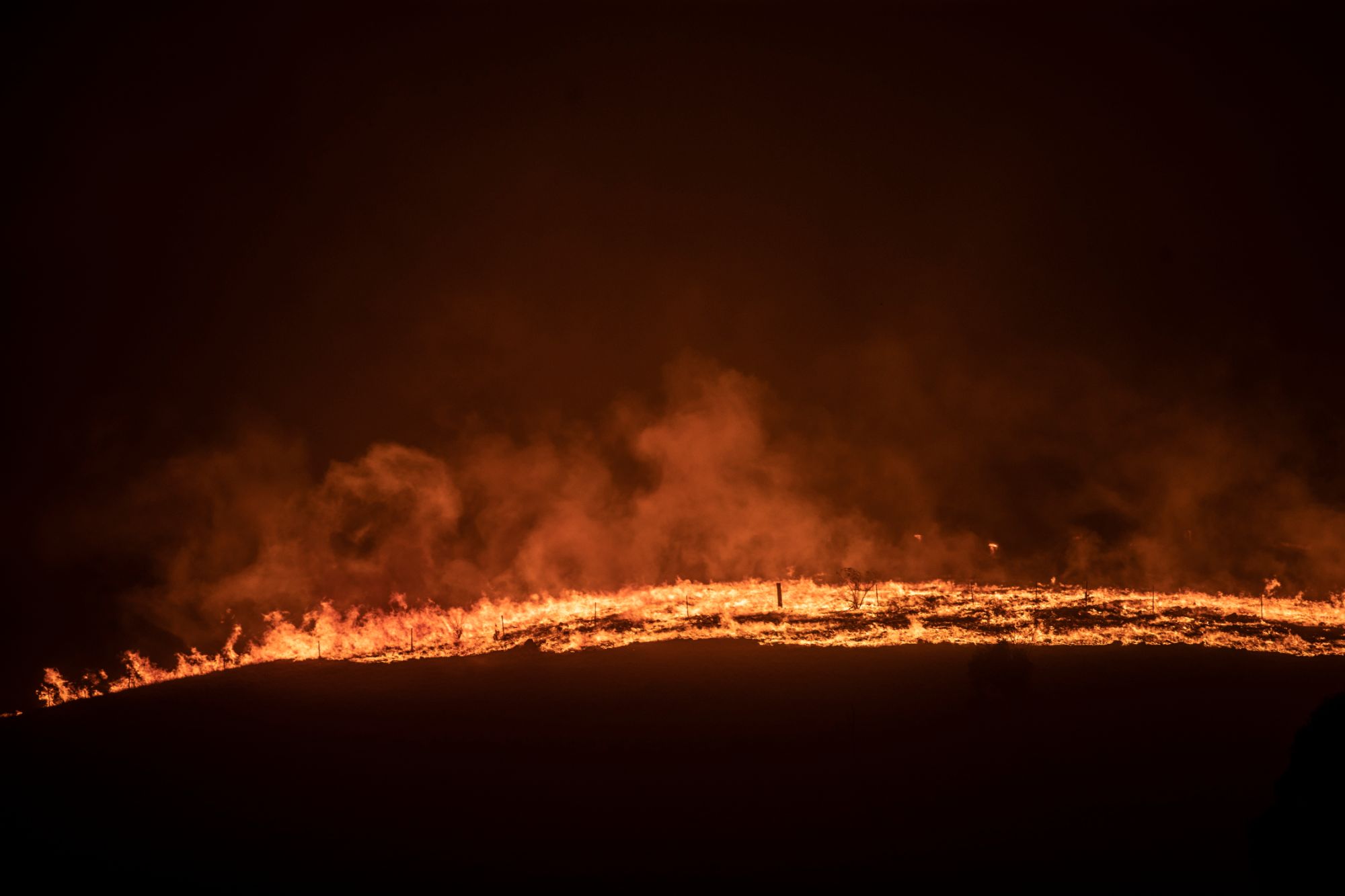
Brook Mitchell
Getty Images
The Clear Range Fire burns through the property of Lawrence and Clair Cowie near Bredbo North on February 1, 2020 near Canberra.
The story behind the shot
“These images were taken near Bumbalong, just off the Monaro Highway, on what would turn out to be the last fire burning at the emergency warning level. I had been in Canberra for the previous few days covering the Orroral Valley fire as it crept north towards the city. With a change in wind direction a spot fire sparked in NSW, which became the Clear Range Fire.
“I and some other photographers and journalists were at the property of Laurence and Claire Cowie as the fire approached. The property was surrounded by grassland, which, when the fire hit, went up with incredible speed. Very quickly we were largely surrounded by the fire. It was an incredibly tense time, and thankfully only the shed and stables were lost. Claire’s American quarter horses, pure white against the black and orange of the fire, certainly stand out as a memory for me.
“I visited the property a month later, and it was as if it had never happened, save for the ruins of the shed. There was knee high green grass as far as you could see. Surreal.”
– Brook Mitchell
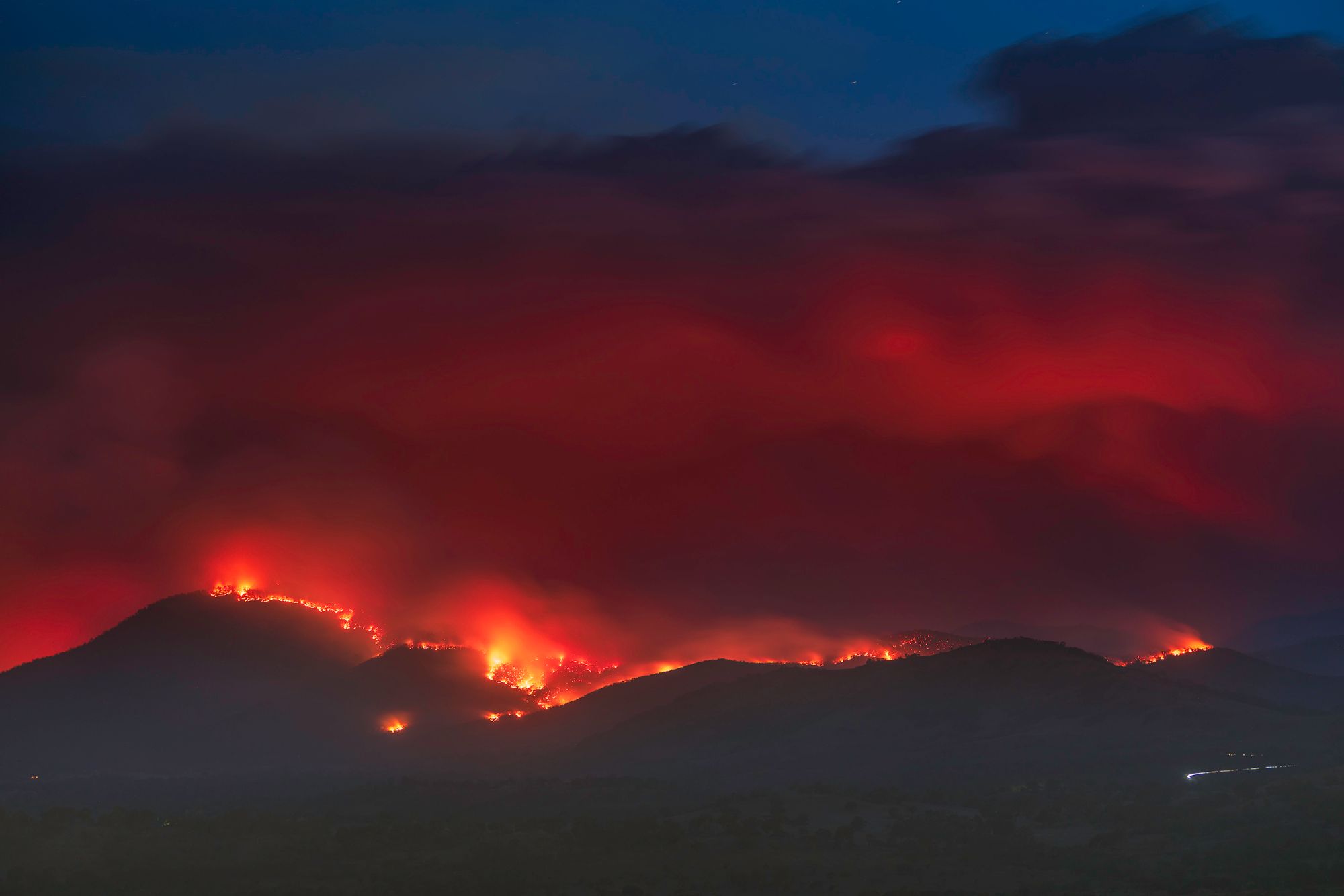
Wade Selwood
Head On Photo Festival
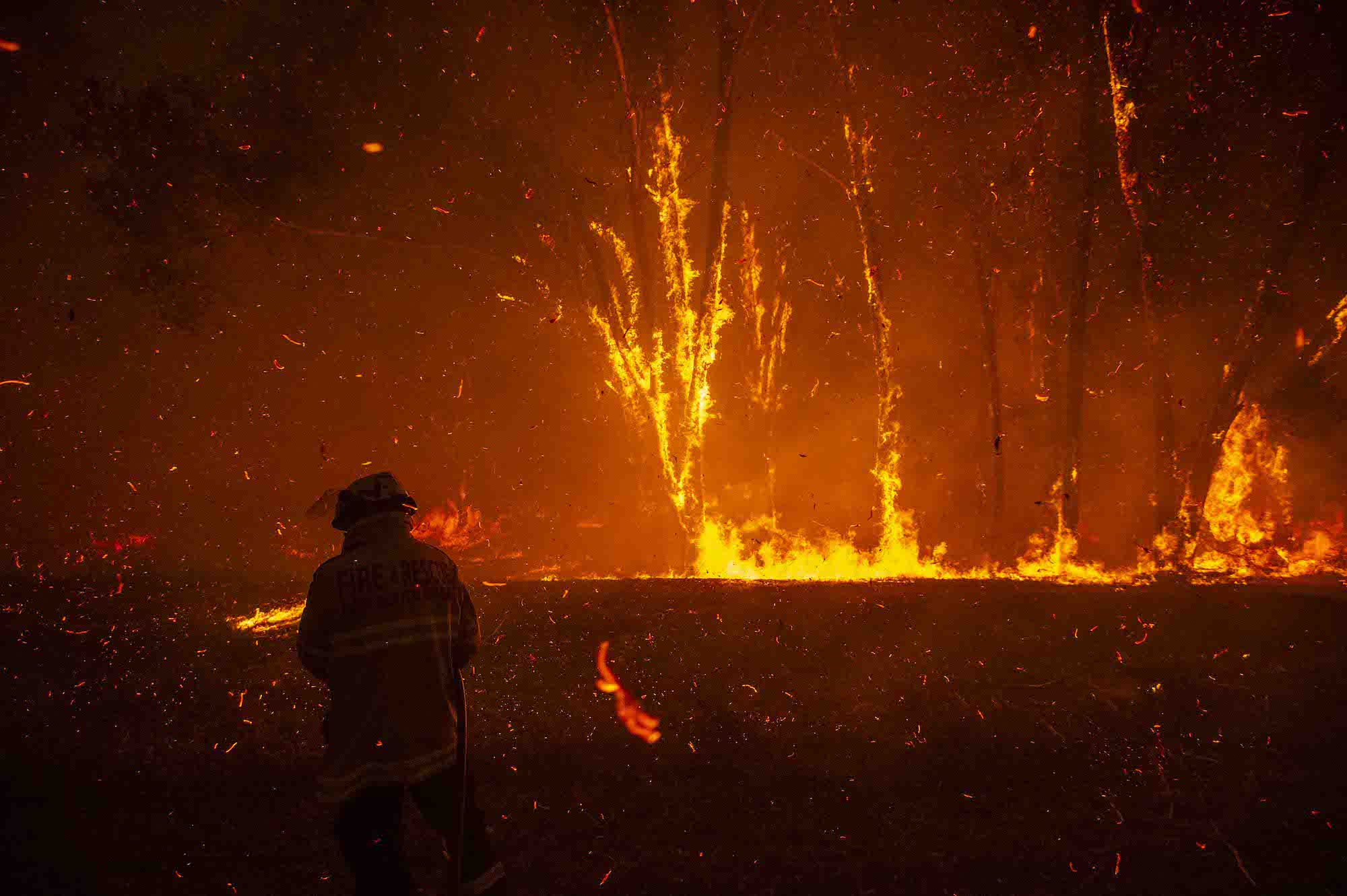
Wolter Peeters
The Sydney Morning Herald
An FRNSW firefighter under ember attack as the Three Mile Fire impacts properties near Mangrove Mountain on December 5 2019.
The story behind the shot
“The fire had been stuck in behind properties for a couple of days and was finally making a run towards some of the properties – this was about 6:30pm on that particular day. There were New South Wales Fire and Rescue (FRNSW) crews in attendance, and they were working really hard just to look after the assets there.
“The FRNSW crews were having trouble with one of their pumpers… The stress levels were high, just making sure they wouldn’t start losing buildings and infrastructure. When they’re in this property protection mode, they’re really just looking out for the properties and any sheds or buildings. They’re not actively trying to get in there and fight the fire. In these conditions, with the winds they were experiencing, there were lots of ember attack happening…it was just really difficult conditions for them. This was a blast of wind that just sprayed everything with embers and started more spot fires.
“I stayed with this fire for a couple of days. It was in an area that had very patchy phone coverage, so trying to cover this and file pictures before deadline is always tricky. Sometimes you’ve got to go in, shoot some frames, and then if you’ve got something decent pull out again, try and find some reception and file some pictures, and then head back in again. Just challenging working conditions, but very privileged to be in amongst the crews when they’re doing their job and working really hard to protect people and properties and lives.”
– Wolter Peeters
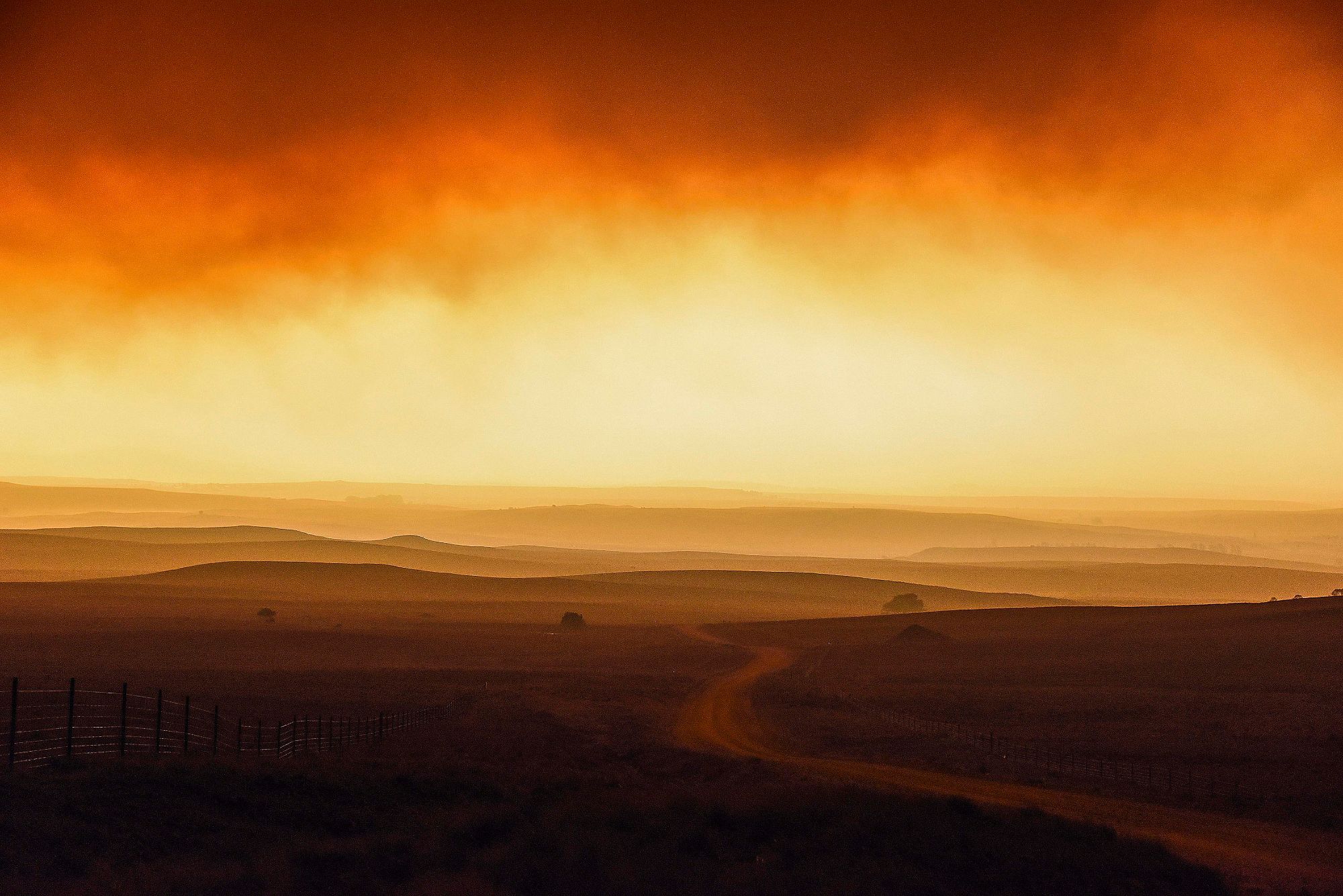
Paul McIver
Head On Photo Festival
Title: “Out of the Pyro”
The story behind the shot
“The first fire I photographed this season was in August 2019. There was snow in the background! As the season wore on the fires became more frequent until the pyro cumulonimbus event of New Year’s Eve generated by the Badja and Good Good fires around Numeralla. This fire would later claim the air tanker. Midday looked like midnight, but no one was celebrating. No one had ever seen anything like it before as day was turned to night and a sense of foreboding descended with the cloud of ash and smoke.
“We drove for over fifteen kilometres into this event, with lightning striking around us intermittently, before losing our nerve and turning around to follow those fleeing back out. This image was taken as we exited the event. I went on to file occasionally for the Sunday Telegraph in Sydney in the weeks and months ahead. Exactly a month later an offshoot of this fire destroyed my home of 30 plus years. No one has seen such times before. If I could ask but one thing it would be, can we please start being kinder to our mother!”
– Paul McIver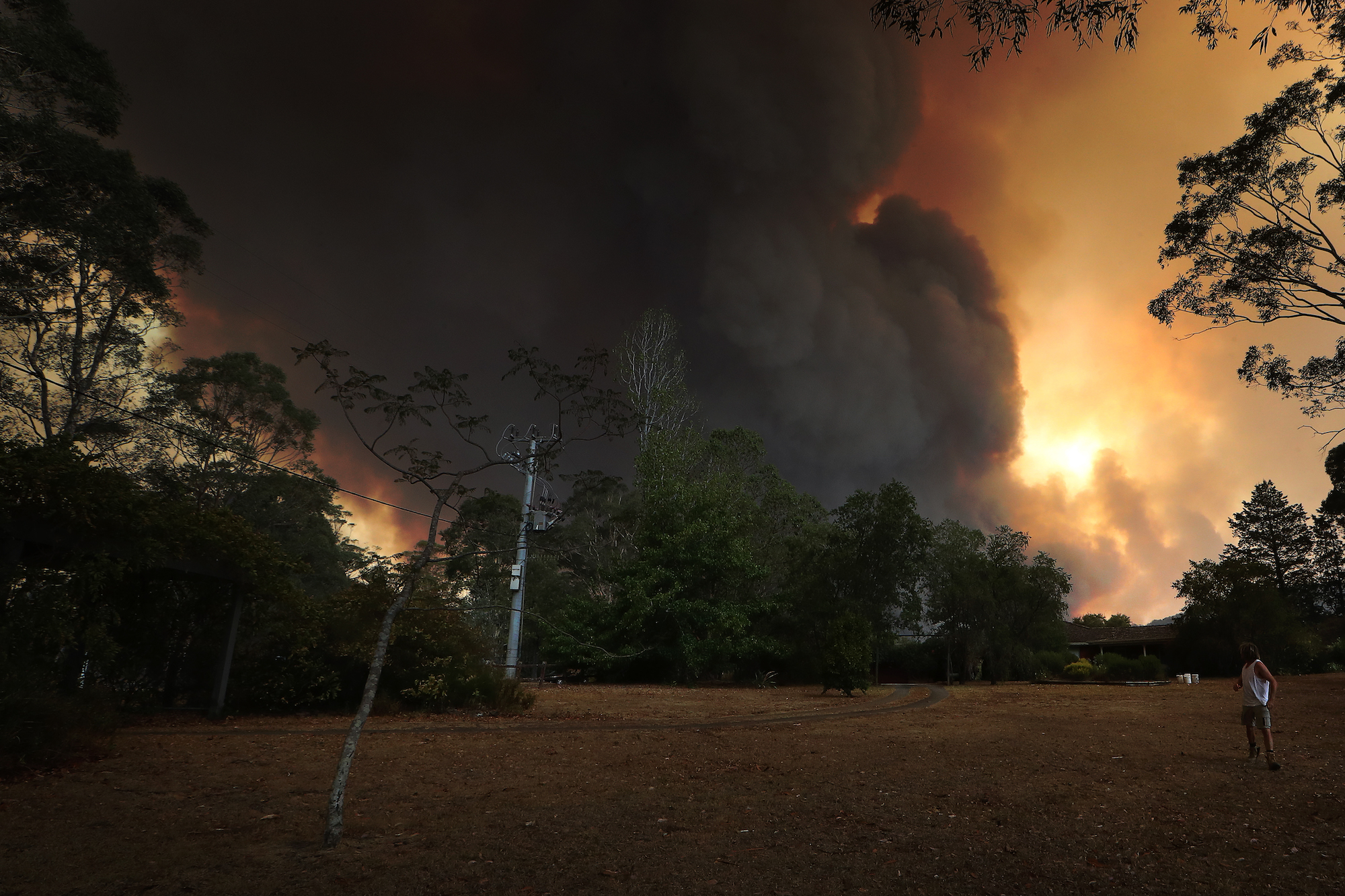
Sylvia Liber
Illawarra Mercury
Title: “Currowan Inferno”
The story behind the shot
“I was at Tapitallee when the Currowan fire was moving south-east from Burrier and Buangla, through Illaroo, and the hot, humid conditions caused the fire to jump the Shoalhaven river. Within minutes the weather conditions converged and formed a dry thunderstorm, causing erratic winds and dangerous fire activity. Residents were terrified, as the fire created a six-kilometre high column of smoke above Bugong.
“Property owners were being told to leave but many chose to stay and fight spot fires. The man from my photo lived next door to an open field and was running to knock down a fence to make it quicker and safer to seek shelter once the fire came. Residents could only look to the sky, watch and wait to see if the fire would spare their homes. A southerly change with strong winds arrived soon after, pushing the fire towards Kangaroo Valley and sparing their homes.”
– Sylvia Liber
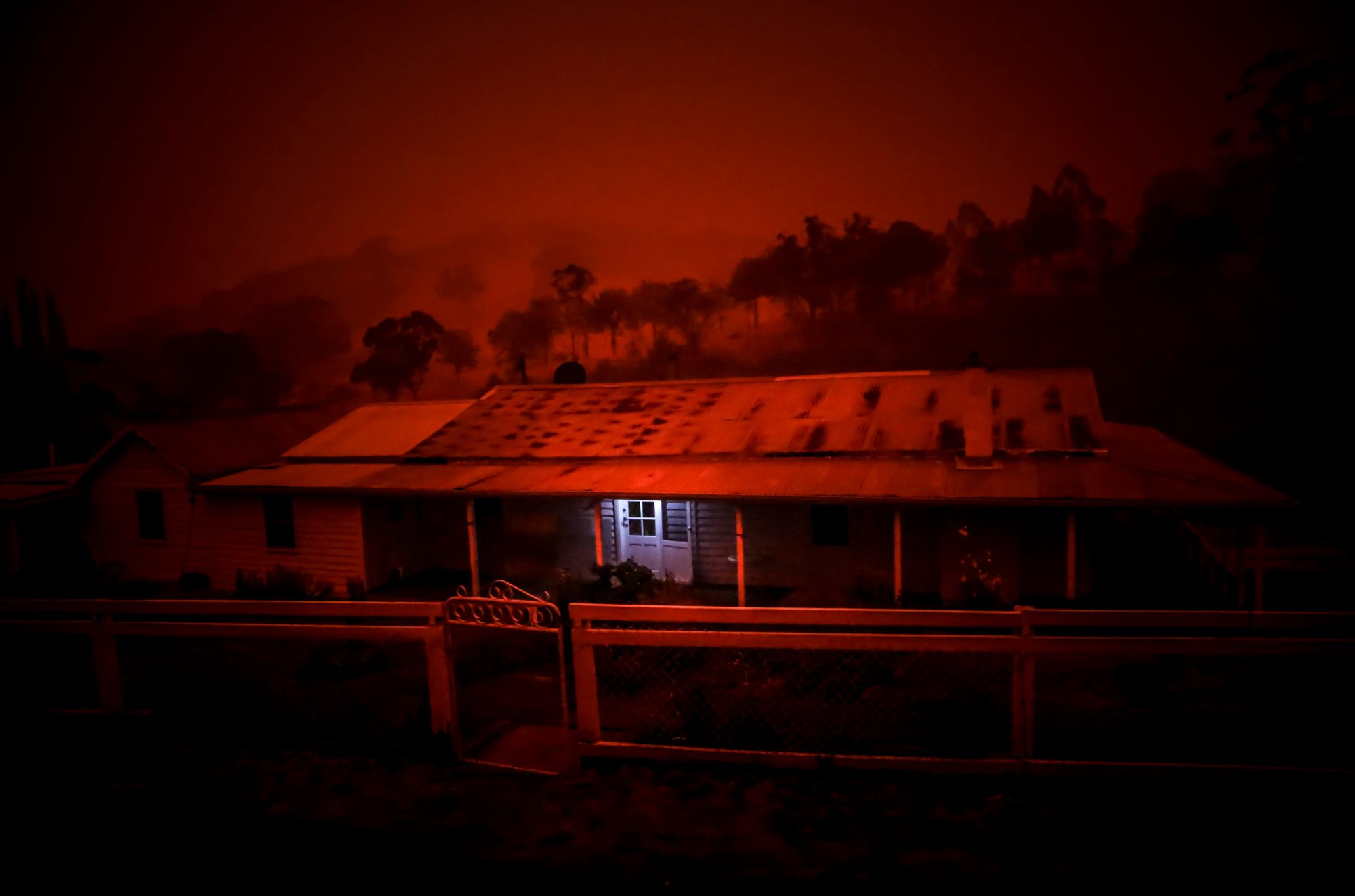
Skye Auer
Head On Photo Festival
Title: “Dark Day”
The story behind the shot
“I took it while checking on our neighbour in Tubbut, Far East Gippsland. Conditions came in fast that afternoon, with the smoke thickening and darkening while a fine rain of ash drifted from the sky like snow. As conditions worsened, burned leaves and bark flew around on the afternoon wind and it felt like our time might be imminent.
“The light went from deep twilight to the thick velvety midnight that you only experience in a terrible fire when the pyrocumulous collapses”
“In the 20 minutes it took me to walk to her home and back, the light went from deep twilight to the thick velvety midnight that you only experience in a terrible fire when the pyrocumulous collapses. Our sheep made their way to camp, the cockatoos screeched in the trees, settling for the night… I snapped this just moments before all natural light was gone completely. It was two hours before a hint of glow returned to the sky, just in time for an ominously dark twilight and another long, vigilant night.”
– Skye Auer
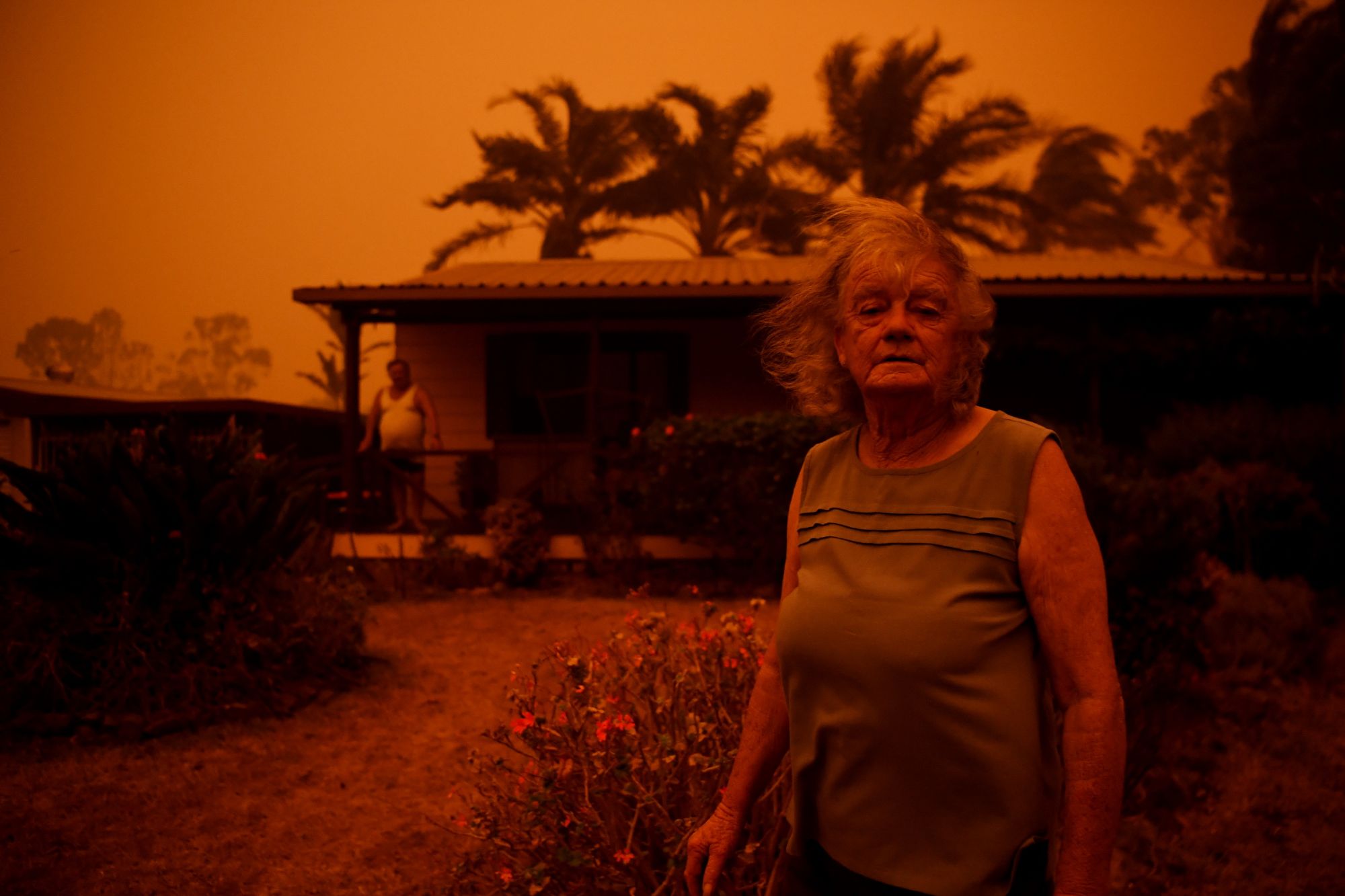
Tracey Nearmy
Head On Photo Festival
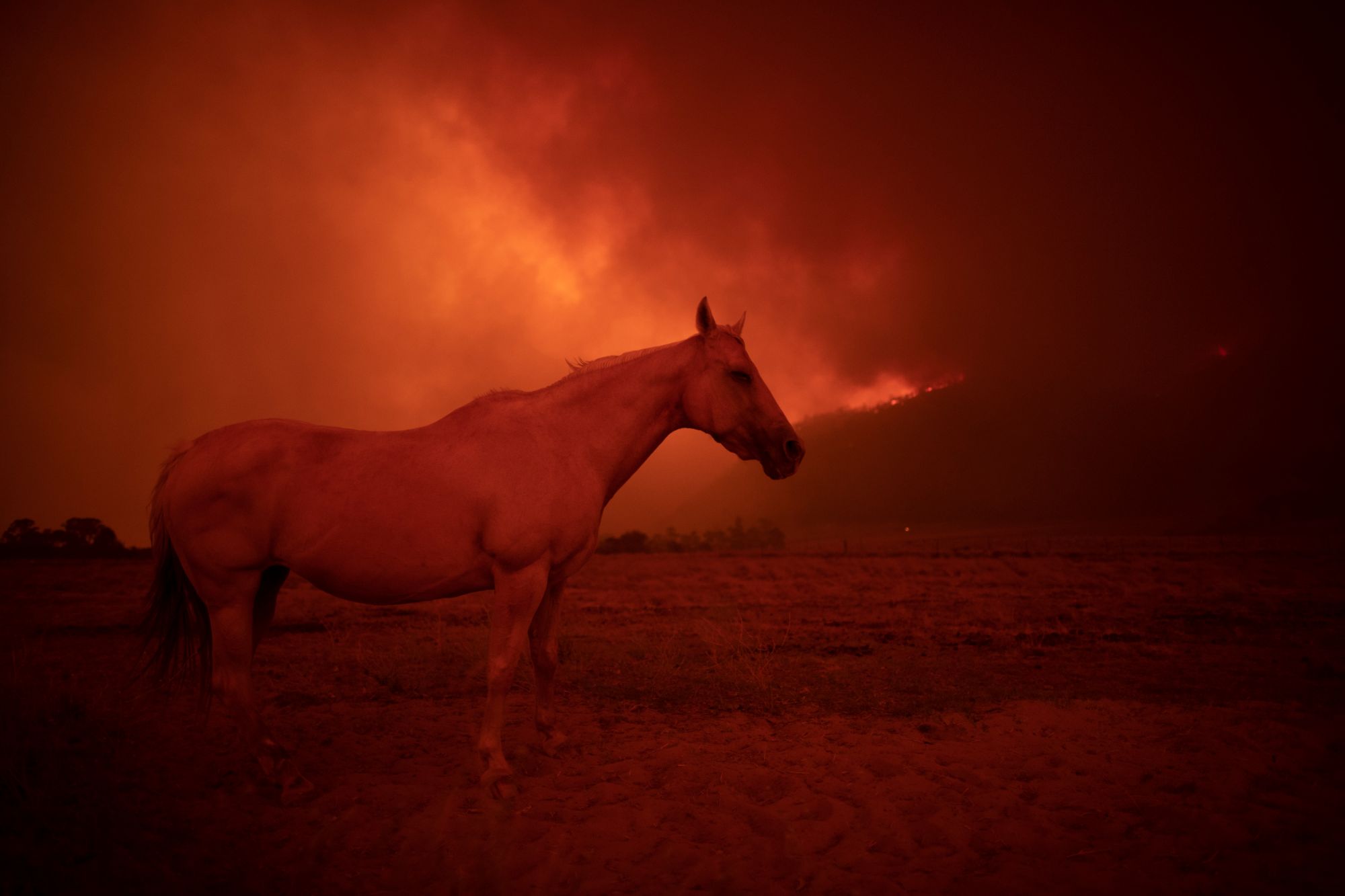
Brook Mitchell
Getty Images
A horse on Bumbalong Road, Bredbo North, near Canberra, on February 1, 2020.
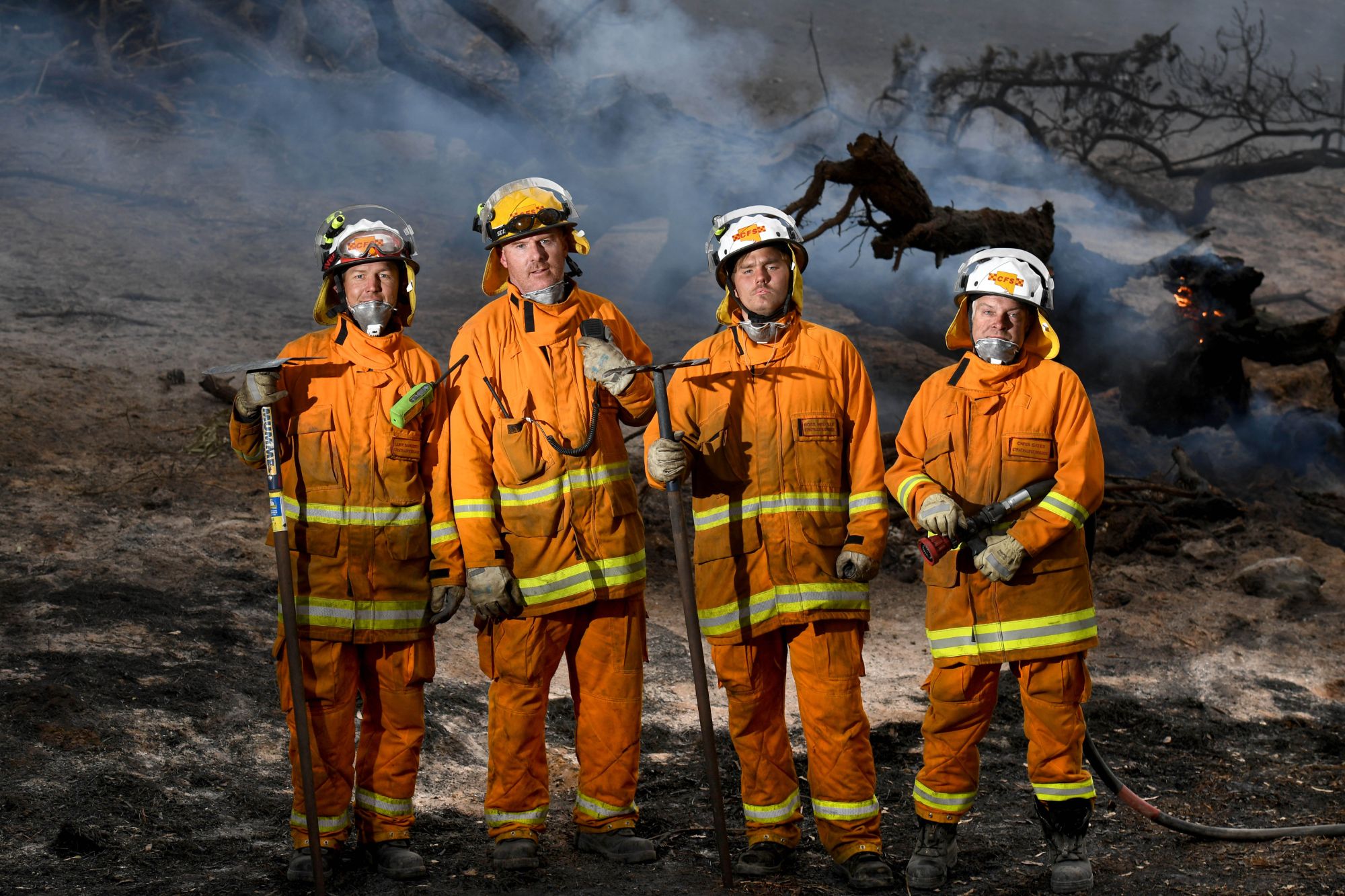 Tricia Watkinson
Tricia Watkinson
The Advertiser
Cudlee Creek Fire – CFS Heroes: Strathalbyn Brigade volunteers (l-r) Luke Sanders (37), Rodd Brickmann (47), Ross Melville (18) and Chris Gates (48).
The story behind the shot
“The devastating Cudlee Creek fires took off on Friday the 19th of December. I’m a Hahndorf local, Adelaide Hills – my house was in the path of the fire front, we were on a ‘watch and act’. Neighbours were leaving. I rolled out my hoses, but I hoped for the best, and took off with journalist Andrew Huff towards the fire front – which wasn’t far from me – to report on what was going on… The fire had come through Harrogate and Brukunga. It was terrible – really, really burnt out. Burning animals. It was horrific.
“On Sunday, the editor on the day wanted a photo of the amazing CFS (Country Fire Service) volunteers that we were hearing story after story about; of the heroic things they were doing to save lives and people’s homes. Of course, they’re super busy, some are a bit shy and some didn’t want the attention. [But] we came across this really, really, cool team of four from Strathalbyn CFS. They were just finishing off their long hours and were happy to [be photographed] once we had a chat about what we were trying to achieve. We just wanted to celebrate the amazing things they were doing and give credit to them.
“I explained that I was looking for a particular area that we passed on the way there. We were driving back through the fire ground that had been burned, and logs were still on fire. I saw the spot and told them to pull over – it was quite surreal, quite Armageddon-like. It was perfect for a backdrop, as tragic as it was. It really set the scene. There was this amazing tree that had fallen over and was still smouldering; just all this smoke coming up from the ground. The ground was so hot and it was days later.
“It was quite surreal, quite Armageddon-like… this amazing tree had fallen over and was still smouldering; just all this smoke coming up from the ground. The ground was so hot and it was days later.”
“They were all covered in soot and looked exhausted, but with incredible resilience and amazing camaraderie. They were just so welcoming and so honest, and the more we spoke to them, I could’ve listened to them for hours.
“On the day of the fire, they drove through a fire front. They had 20 minutes to plan when they got to the next town, Harrogate, to save the homes, and they said that they basically couldn’t keep up with the fire front. It was insane. I think it caught us all by surprise, the ferocity of it. They actually sped through [the fire], got to the other side, flattened it, drove 20 minutes to get to Harrogate, and they saved every single house.
“It was unbelievable. The editor loved it and spread it across two pages. It was one of my favourite photos, if I can say that, from the horror of it all because it shows the amazing people out there that put their lives at risk and are just willing to do the right thing, I guess. They don’t want hero status or anything. They just do what they do because they’re good, decent people who are extremely community-minded, and I’m so grateful for them because this is my town, these are my hills, this is where I live, and they’re amazing people.”
– Tricia Watkinson
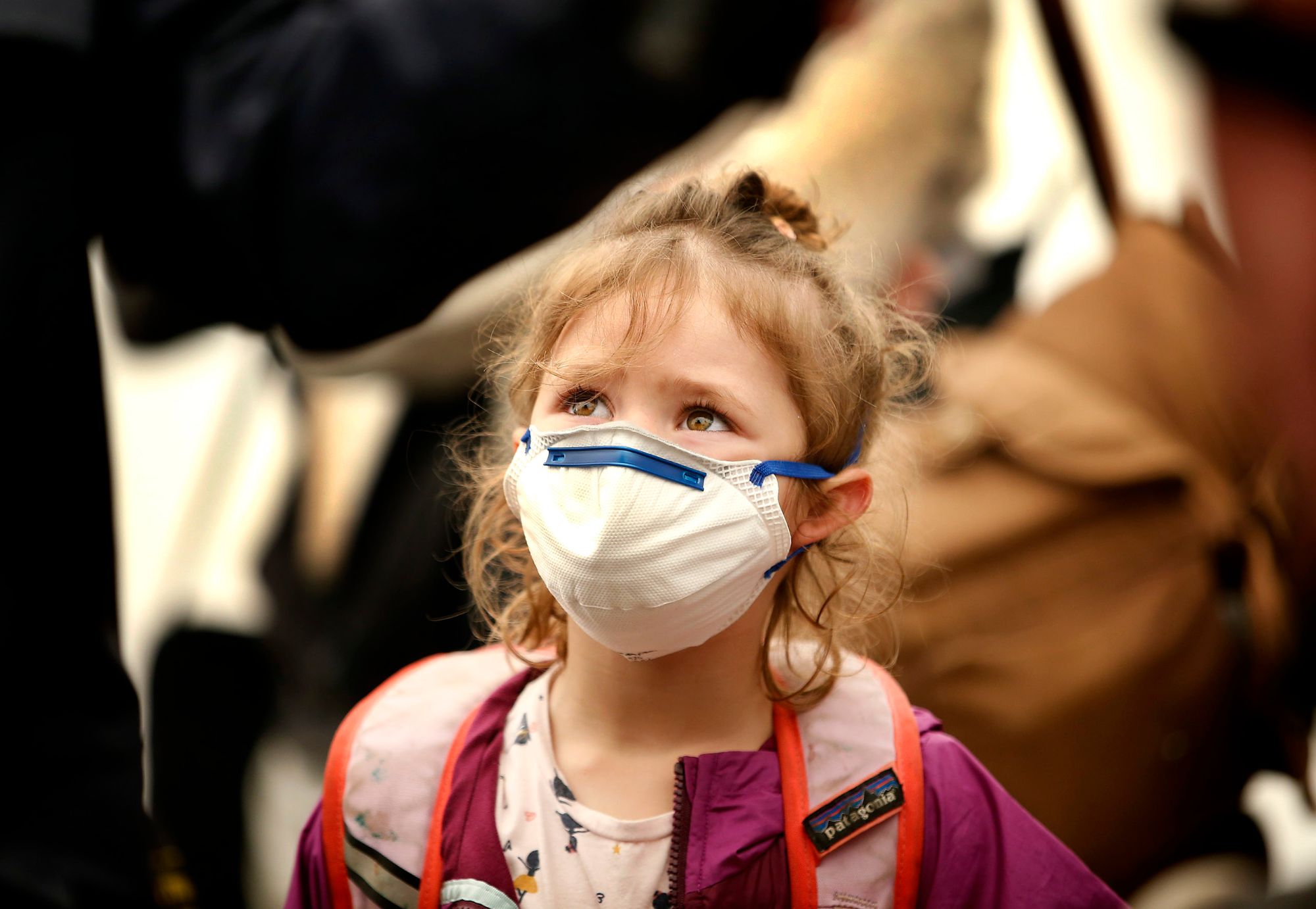 David Caird
David Caird
Herald SunHerald Sun
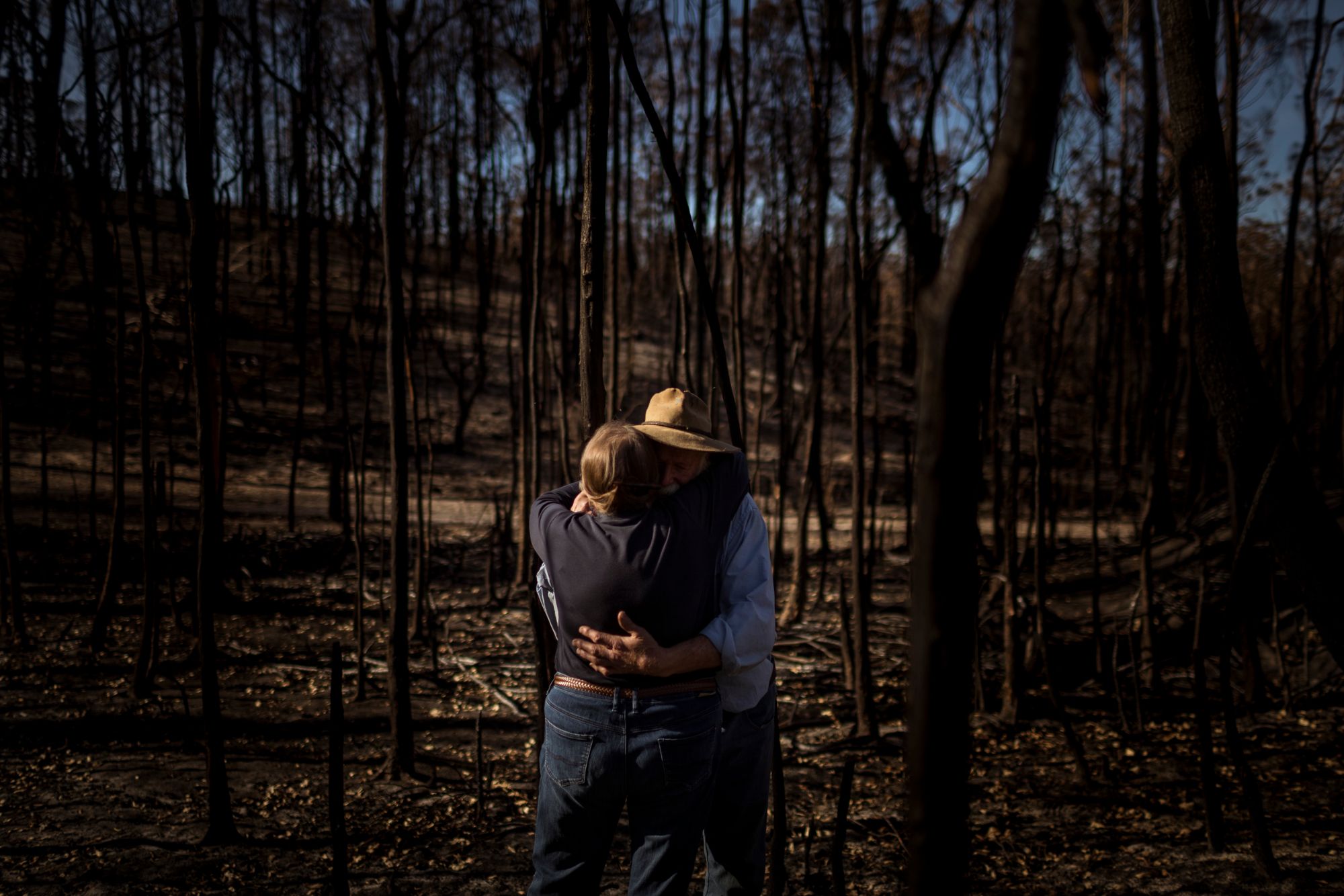
Chris Hopkins
Getty Images
The story behind the shot
“On January 12 I was on assignment for Getty Images, looking for stories of carnage and hope in the immediate aftermath. The tiny farming community of Wairewa had been hit hard with over half its homes destroyed, and with smoke still billowing from nearby bushland, the threat was still at large. Brian and Elizabeth Blakeman had stayed and fought off the fire that tore through their hilltop property. They saved the house but the rest of the property and out buildings were a blackened mess. While their spirits were reasonably high, the emotional toll had started to have an effect on their resolution. Brian was ‘battle weary’ and, like most others, they were unsure as to the next step in the recovery process.”
– Chris Hopkins
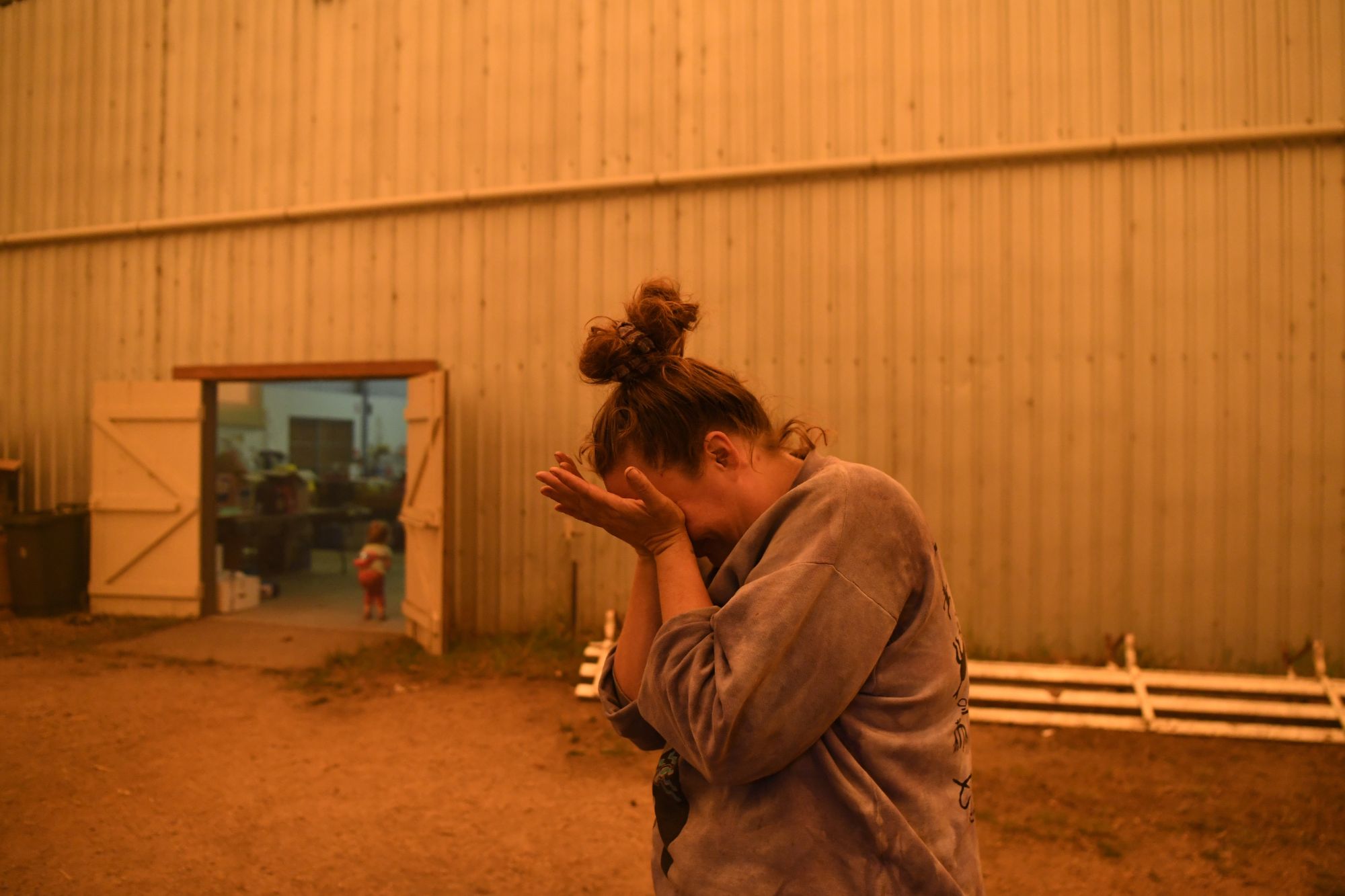
Tracey Nearmy
Reuters
Jesse Collins, who is running how the personally organised donations are distributed, becomes distressed as she speaks about how hard getting water has been at the evacuation centre in Cobargo, Australia, January 5, 2020.
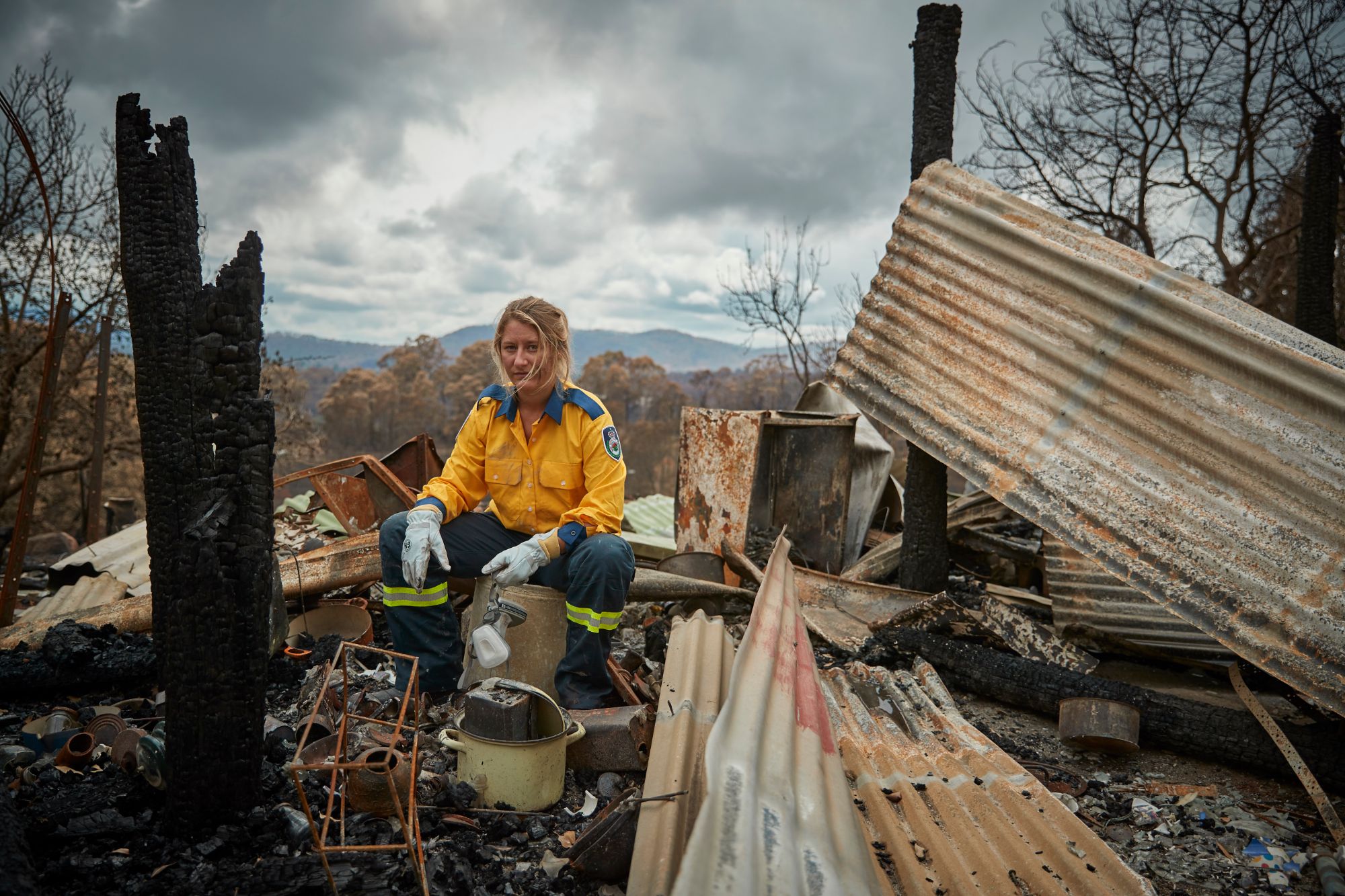
Kiran Ridley
The Sydney Morning Herald
Volunteer Firefighter Anika Craney at the burnt out remains of her home in Verona on January 9, 2020.
The story behind the shot
“This photograph was taken on assignment for the Sydney Morning Herald. I was lucky to have quite an open brief to head towards South East NSW to document the incredible damage done by the fires and the human stories that it had left. Having heard that Cobargo was one of the most impacted areas, I headed to the showground at dawn. I ended up having breakfast with a group of weary RFS (Rural Fire Service) volunteers, one of whom was Anika, whose story was moving. Having moved to Cobargo two years ago in search of a more sustainable life on the land and lower carbon footprint, Anika lost her home to the Badja Forest fire that ripped through the area, one of five or six in her brigade to do so. She was away from her property at the time of the fire and by the time she got there it was too late.
“That day Anika was heading back to what had been her home for the first time since the fire, so I asked if I could join her. Arriving there, it was very still and eerily quiet. Conscious of my presence and trying not to be too invasive, I gave her some space. But very soon she started to pick out memories, objects of value which had somehow survived the fire, trying to salvage what could be saved. I photographed her whilst she methodically went about her work, at one point sitting on an old bucket in what was her kitchen. The light was great and her clean bright yellow uniform and blond hair stood out from the grey and blackened landscape. Her look was resolute; courage in adversity. It was important for me to try and capture her spirit; the dignity in her silent despair contrasting with the havoc spread around her.”
“Sentimental stuff is hard to lose but it’s the people that matter. It’s the community now that needs to stick together and that’s the main thing.”
“Stuff is stuff,” Anika said. “Sentimental stuff is hard to lose but it’s the people that matter. It’s the community now that needs to stick together and that’s the main thing.”
“I don’t know if I want to live on this land. Everything is so destroyed. We were on tanks so that’s all gone and we can’t live without water. How do you rebuild?”
– Kiran Ridley
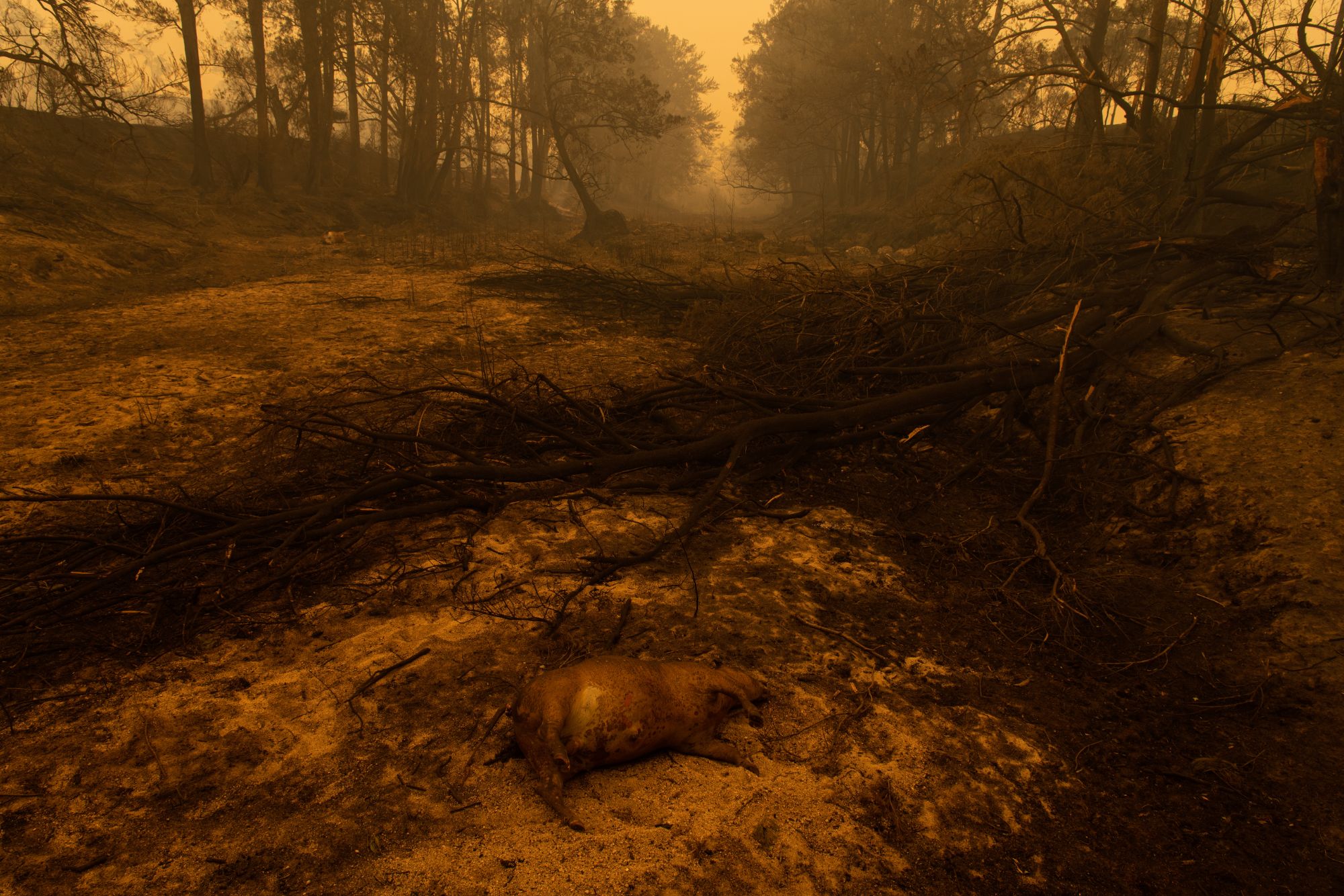
James Brickwood
The Sydney Morning Herald
A dead cow at the bottom of a dried out, burnt stream to the south west of the town Cobargo on the NSW south coast, that was devastated by bushfires.

James Brickwood
The Sydney Morning Herald
The property of Barbara Rugendyke and Dave Rugendyke in Cobargo, a town on the NSW south coast that was devastated by bushfires. They lost their house and all their possessions. The Rugendyke’s have fostered over 400 children.
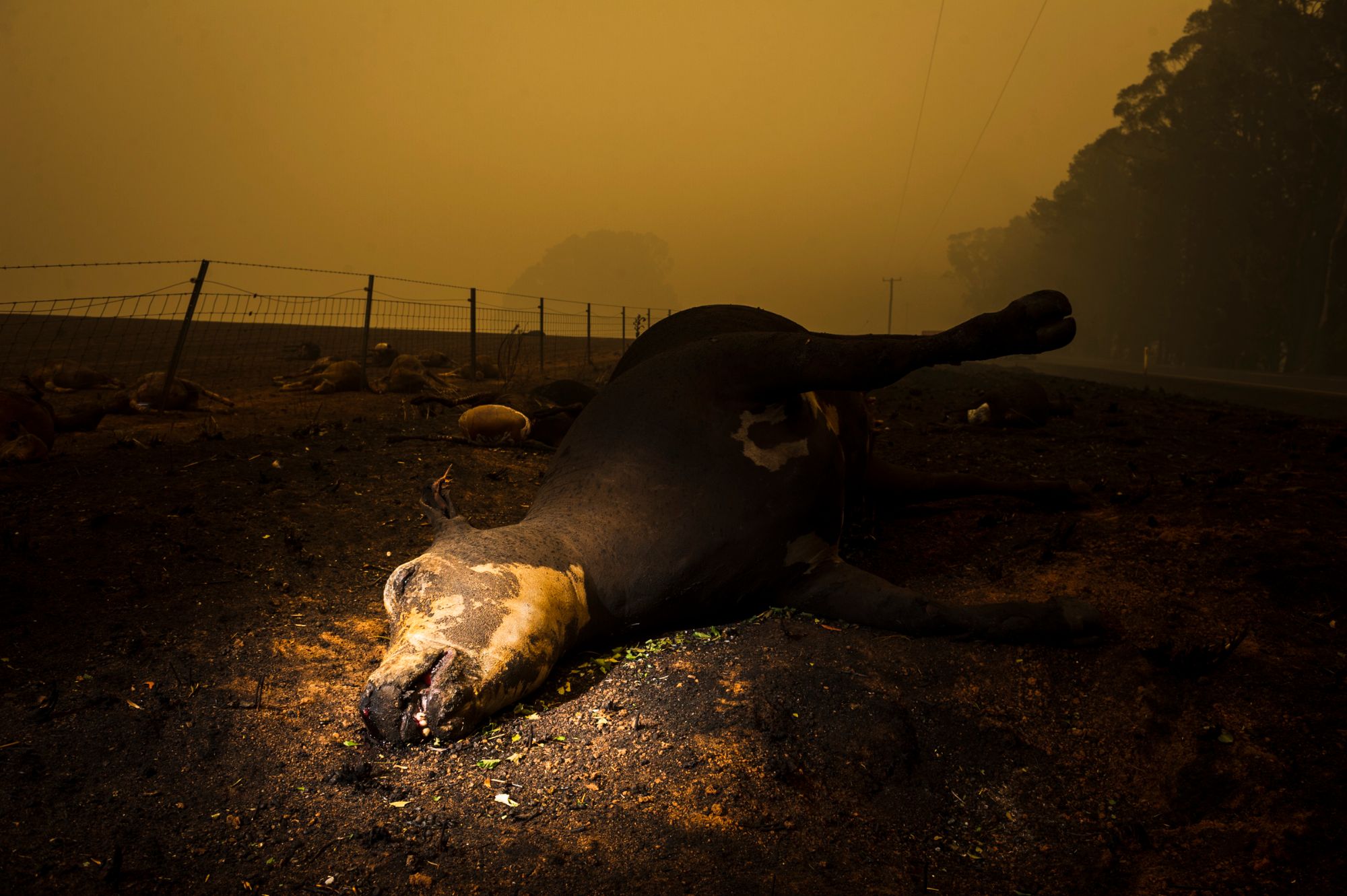 Dion Georgopoulos
Dion Georgopoulos
The Canberra Times
Title: “Aftermath on Batlow Road”
The story behind the shot
“This photograph was taken right outside the town of Batlow next to a farmer’s property on the side of the road. And really, of all the extreme scenes of animal loss that I had seen covering the fires over many weeks, this was truly the most extreme situation. It looked like there were at least a hundred, if not more, dead animals that were littered across the road and the fence line of this farmer’s property, and they were all toppled onto each other. It was really just a horrifying scene to see.
“In other situations, you would see perished animals, but to have so many of them in such close proximity to each other was really just unreal. It appeared the fire must’ve just come behind them and circled these animals and trapped them along the fence line. And even though the fence line had collapsed, they must not have been able to escape. And they eventually all perished.
“I’ve got to say it was really, really surreal to be there. It really felt like a war zone situation. And I’ll never forget this one part, that when I was looking up towards the hill through the smoke haze, I could see one sheep still alive, even though everything else around was just totally, totally dead. And this one sheep was just standing up there on top of the hill, walking around in circles, these small circles constantly, the entire time I was there. And you could tell that it must’ve just been totally traumatised from what had happened. So to see that was pretty devastating. But I’ve got to say, luckily when we got into the town, it was mostly intact. And the firefighters did an amazing job protecting it from such a deadly fire.”
– Dion Georgopoulos
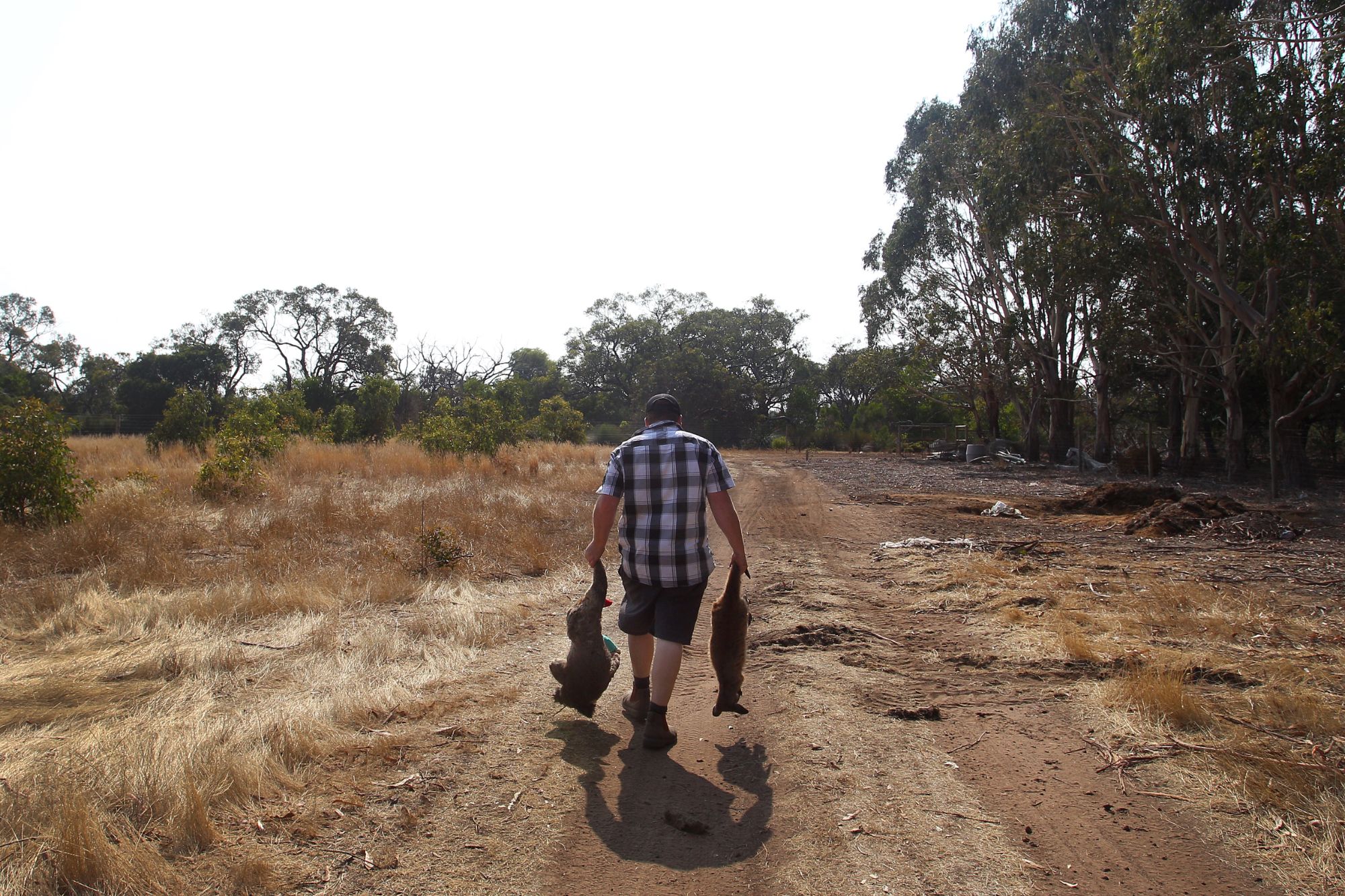
Lisa Maree Williams
Getty Images
Sam Mitchell owner of the Kangaroo Island Wildlife Park in the Parndana region, carries a dead koala and kangaroo to a mass grave site on January 08, 2020 on Kangaroo Island, Australia.
The story behind the shot
“I connected with Sam Mitchell and his family at the Kangaroo Island Wildlife Park as soon as I arrived, as it turned out it was to be a day before the fire-front would surround their home and wildlife park. They were preparing for that possible occurrence while managing the arrival and treatment of injured wildlife from the fire-front – receiving on average 30 koalas a day. A handful of Army Reservists and locals had arrived to lend a hand; land clearing had begun so they could construct more koala pens – it was a somewhat chaotic scene, with everyone working away at an assigned task.
“Sam and I had talked about the importance of telling the bushfire story in a real and honest way, not just showing cute pictures of animals. I was photographing the Army Reservists at the time and out of the corner of my eye caught sight of Sam carrying a koala and kangaroo joey that sadly couldn’t be saved. We met eyes as he walked quickly towards a newly dug gravesite, and without a word spoken indicated that he was okay for me to capture him in that moment. This image became vital in showing the reality of what Sam and his family were facing personally as well as the broader story and enormity of wildlife loss in Australia. I’ve since returned to Kangaroo Island and been able to spend time with Sam photographing the release of some of those injured koalas back into the wild, it’s a real credit to all the hard work they and many others have done in the area.”
– Lisa Maree Williams
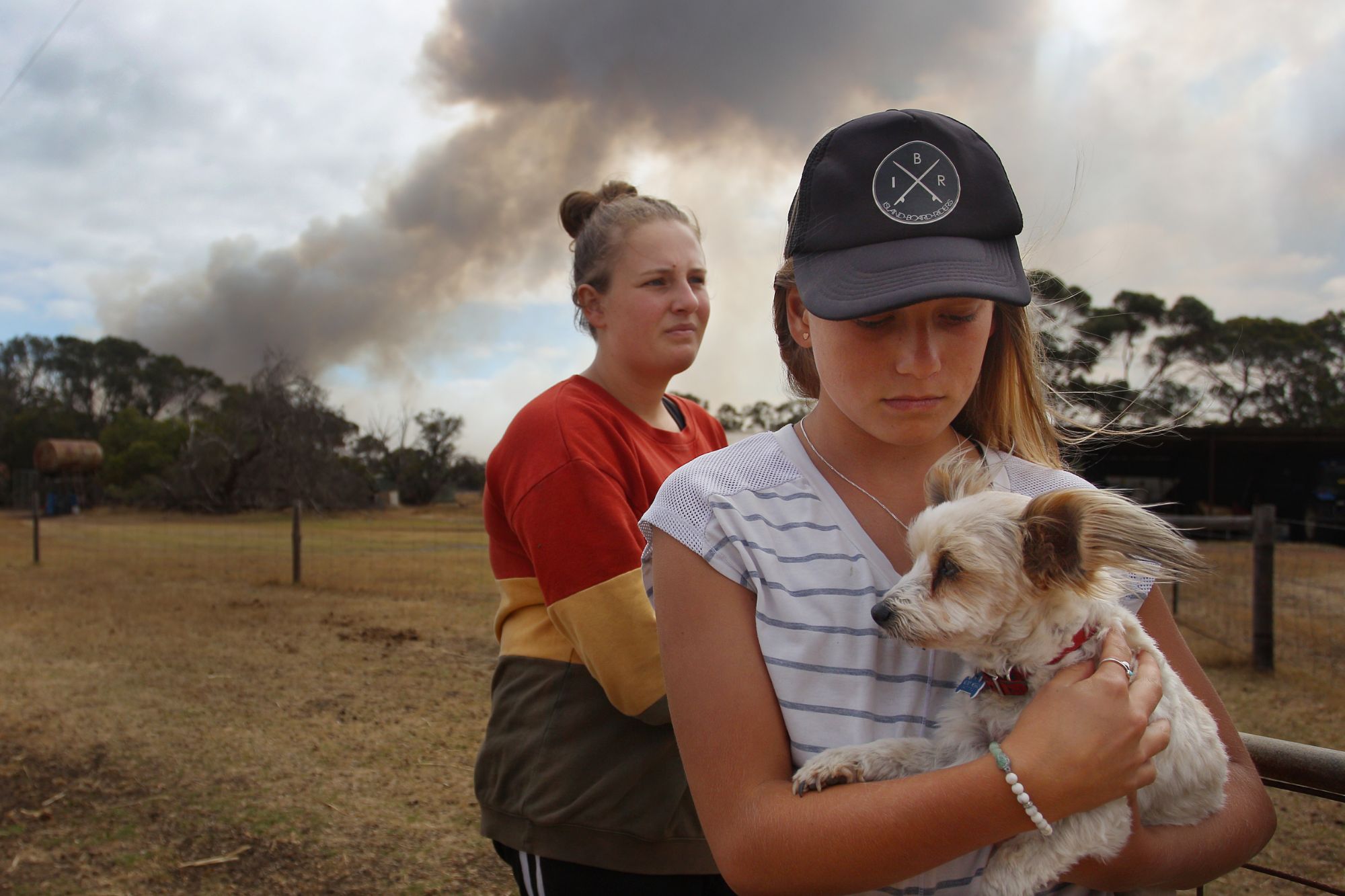 Lisa Maree Williams
Lisa Maree Williams
Getty Images
Bonnie Morris and sister Raemi Morris look on as their family and CFS firefighters battle bushfires at the edge of their family farm on January 11, 2020 in Karatta, Australia.
The story behind the shot
“Kangaroo Island has two paved highways that run the length of the island on either side – this proved problematic during the height of the fires, easily succumbing to closures. Things had subsided on this afternoon and I could finally get closer to farming properties towards Flinders Chase. An ABC crew and I had linked up for a short time and were capturing the Morris family and members of the CFS (Country Fire Service) fighting a large grass fire at the edge of their sheep property, when I noticed two young girls standing in a paddock trying to calm horses.
“The crew were heading on to do something else and I decided to stay – going on to meet and photograph sisters Bonnie and Raemi Morris. In this moment they are putting on a brave face, holding their dog as they watched their father and members of CFS fighting a fire at the edge of their property… a large plume of smoke is seen behind them coming from another blaze along the coastline region. At this stage the Morris family, a long line of farming families in the region, had experienced weeks of fires flaring up in the area – their mother described it as feeling like being in a war zone.”
– Lisa Maree Williams
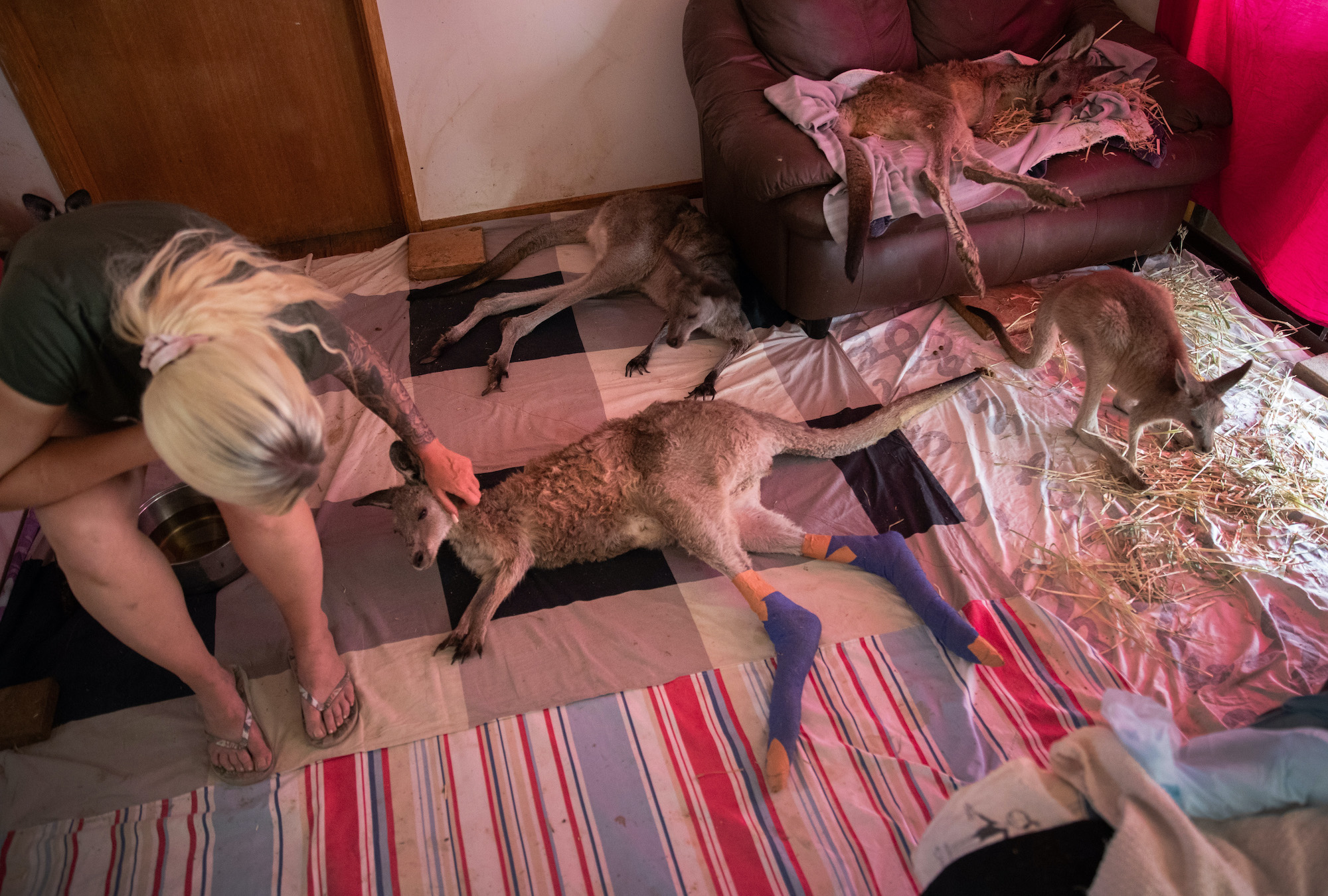 John Moore
John Moore
Getty Images
Title: “The Survivors: Saving Australian Wildlife Following Fires and Drought”
A wildlife rescue volunteer pets a rescued kangaroo at the Possumwood Wildlife Recovery Centre on February 2, 2020 in Bungendore, Australia.
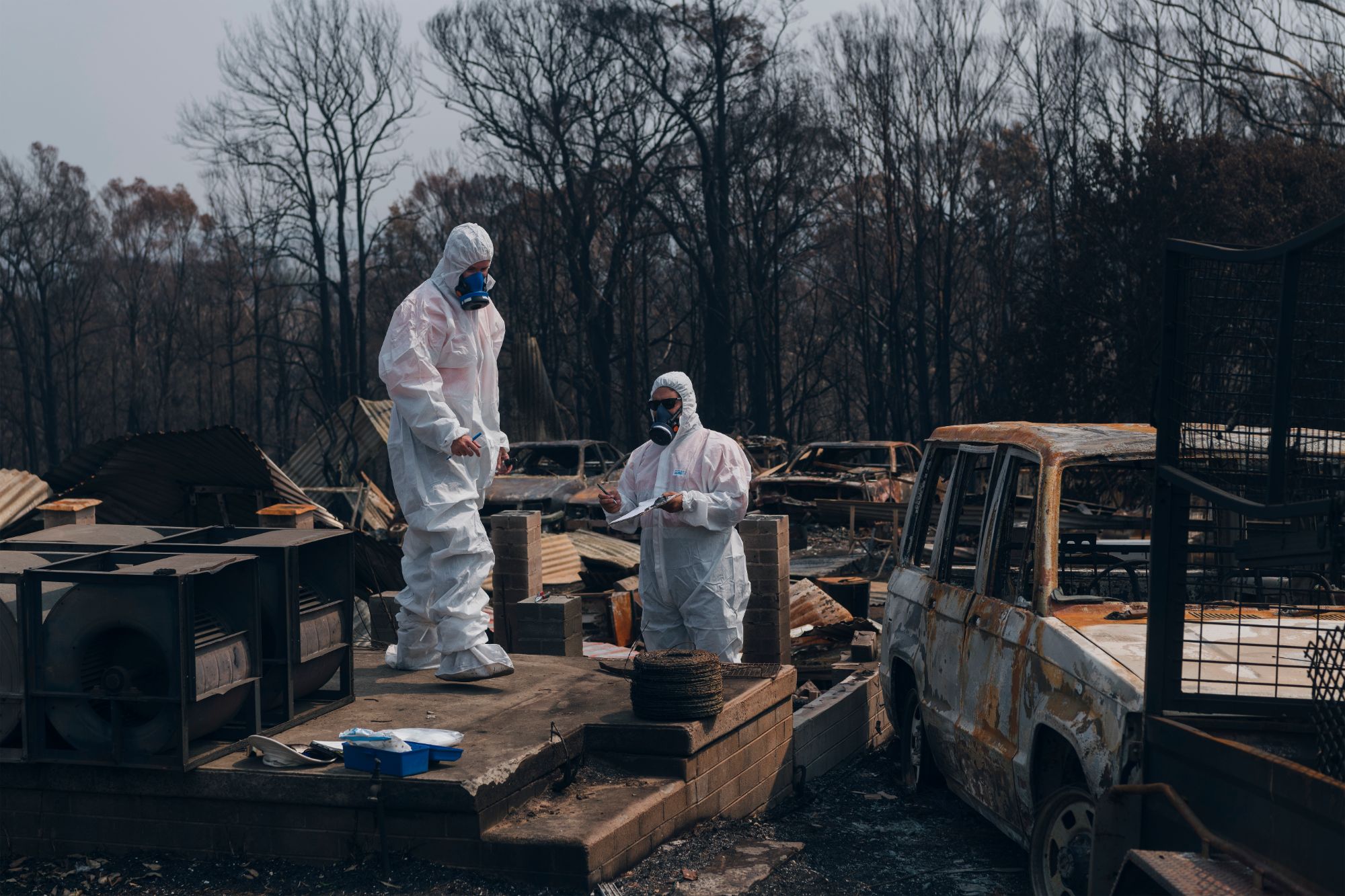
James Brickwood
The Sydney Morning Herald
Licensed asbestos contractors access a property in Conjola Park, NSW, for traces of asbestos after the New Year’s Eve bushfires.
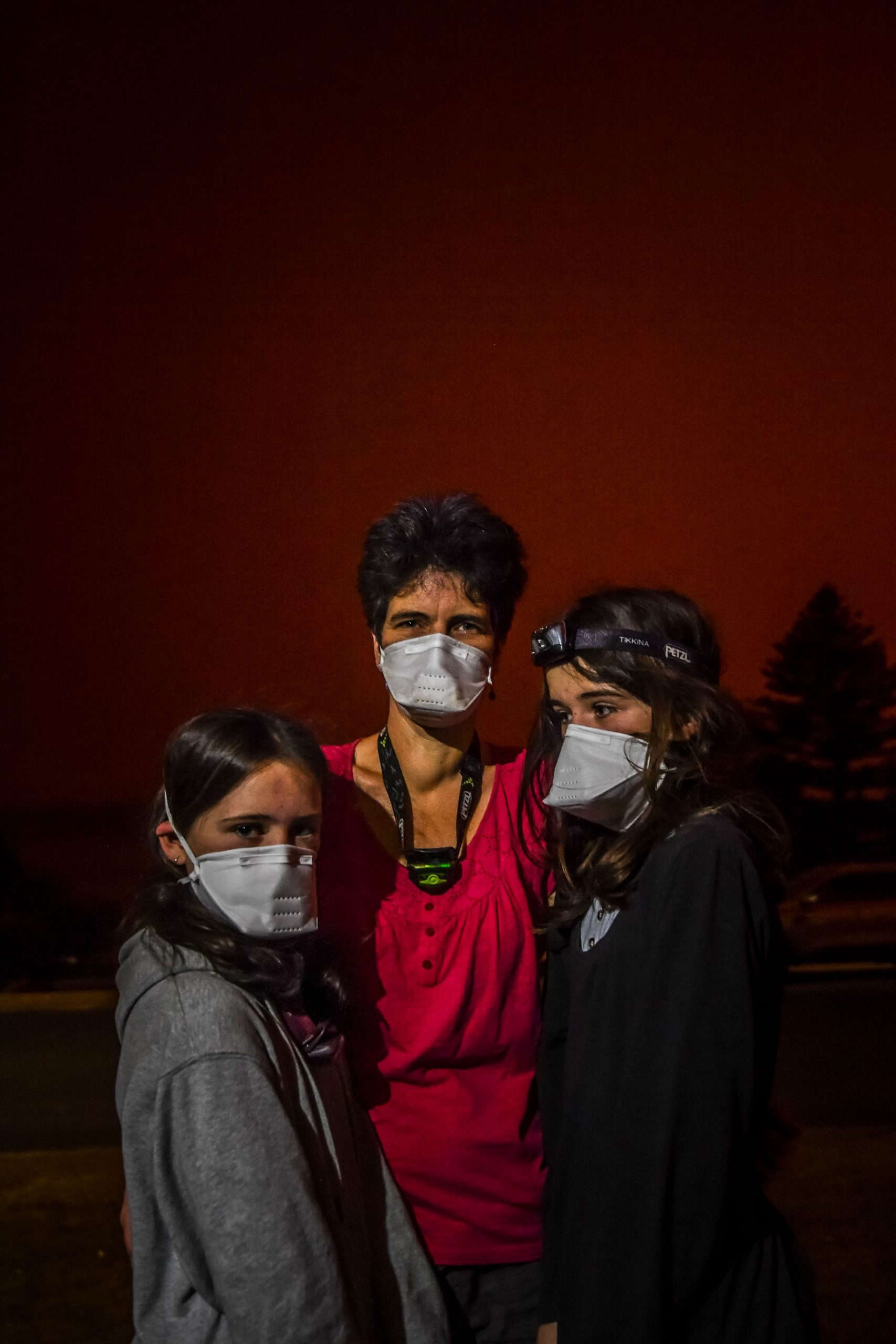
Justin McManus
The Age
Title: “Stranded”
Mallacoota fires. Day turns to a blood red sky in Mallacoota with the South Westerly change sparking up fire activity in the area. Stranded in Mallacoota is Sarah Hollis-Bennetts with children Talia and Tommy.
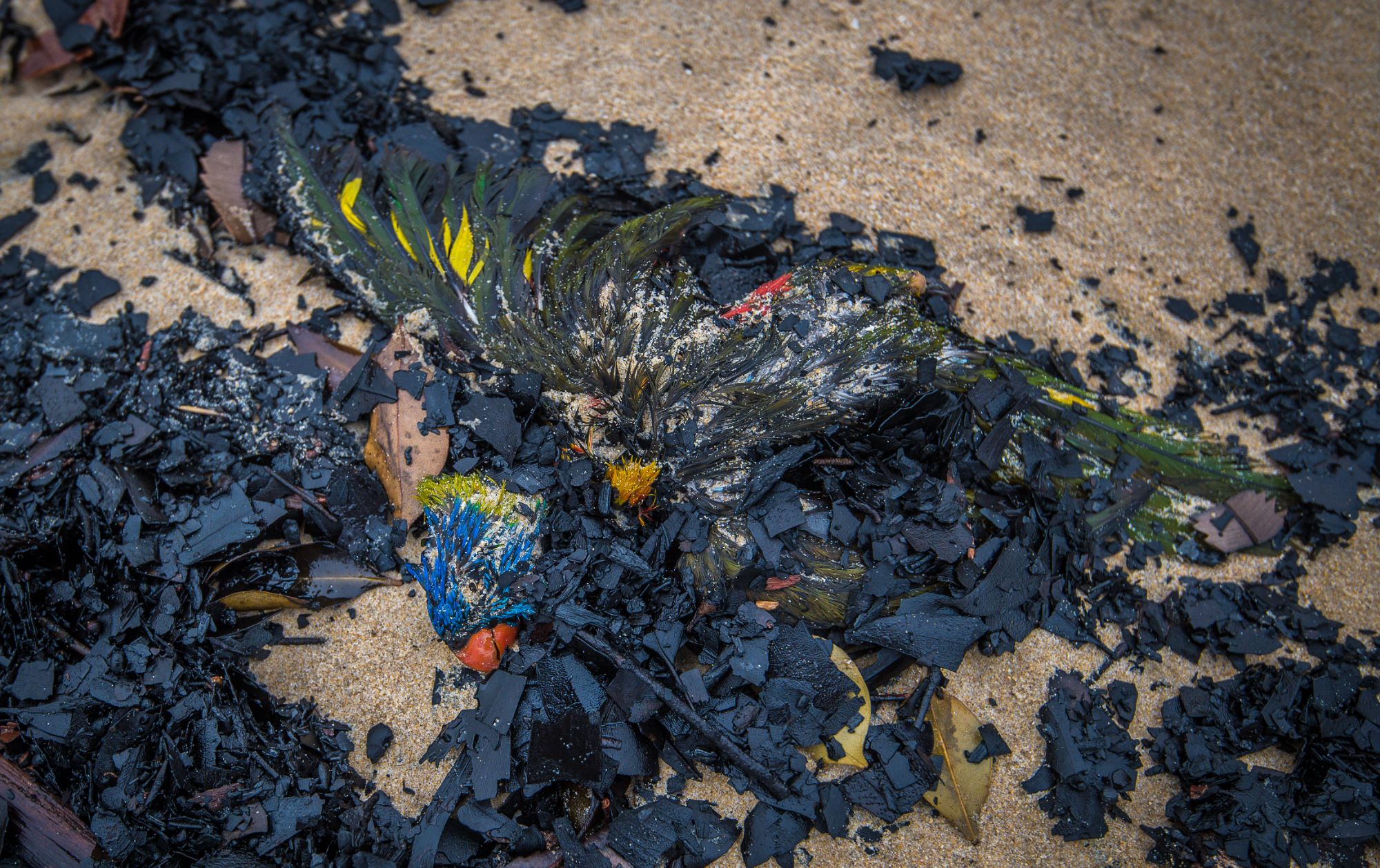
Justin McManus
The Age
Title: “Birds of the Firestorm”
Mallacoota fires. Birds that perished in the fires washed up on Tip Beach just outside Mallacoota.
The story behind the shot
“The image that had the most impact on me during my coverage of the Mallacoota bushfires was the grim discovery of thousands of birds that had been washed up on Tip Beach just outside Mallacoota. I was with colleague Rachel Mounsey and we had heard from a local about all these dead bids that had been washed ashore a few days after the fires.
“We walked along the beach in stunned silence and photographed the scenes of death; it was a macabre process and that felt like an extinction event.”
“We approached the beach and before us was a vast tide of ash and debris that stretched along the length of the beach for a kilometre or more in both directions. Among the ash, hard to see at first, was the familiar bright plumage of some of our most iconic birds. The vivid blues, yellows, reds and greens of Rainbow Lorikeets, Crimson Rosellas, Yellow Tailed Black Cockatoos, Whipbirds, Honeyeaters, Robins. The closer we looked the more we began to comprehend the extent of the carnage; it was overwhelming and deeply sad.
“We walked along the beach in stunned silence and photographed the scenes of death; it was a macabre process and that felt like an extinction event.”
– Justin McManus
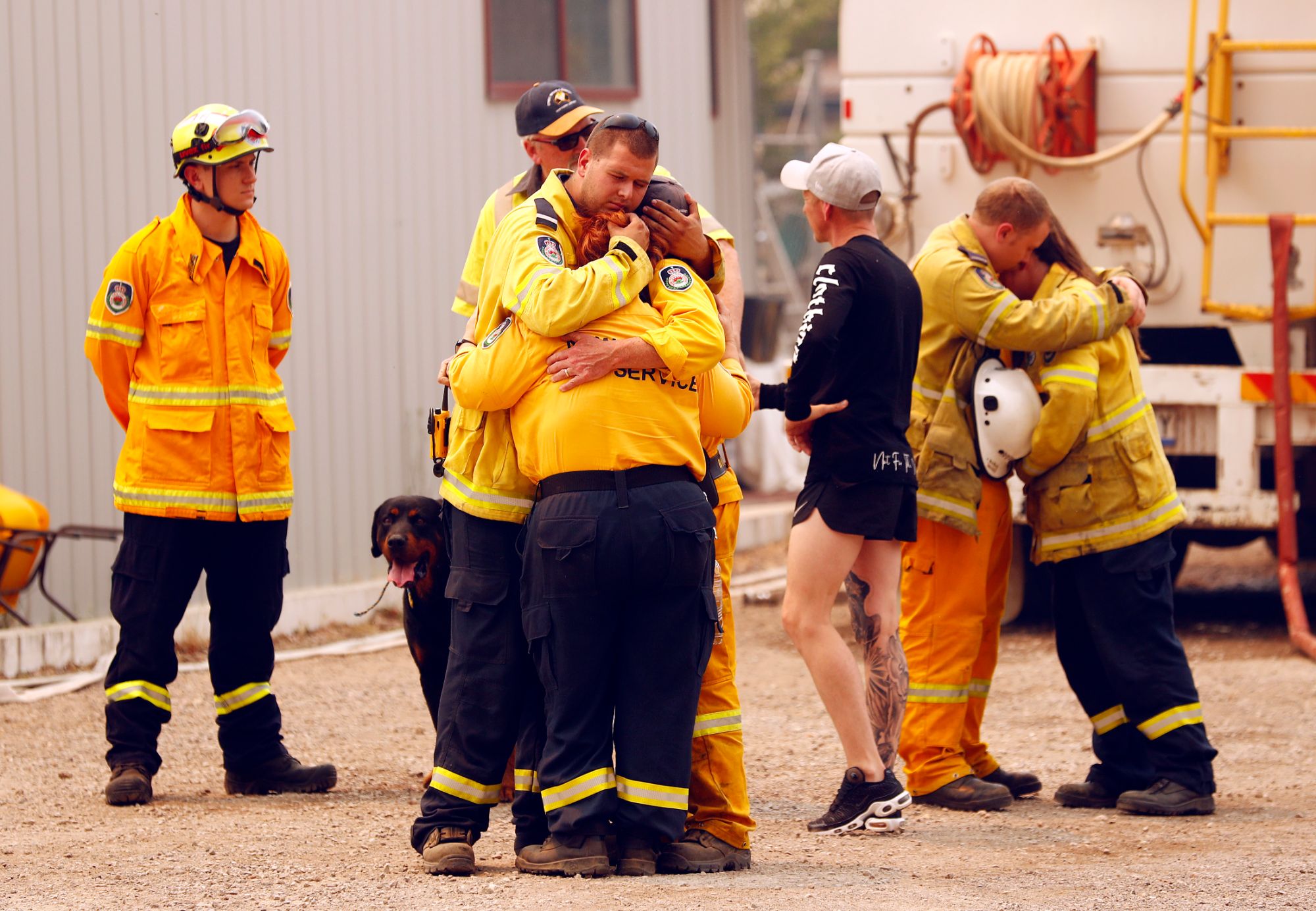
Sam Ruttyn
Sunday Telegraph
Scenery from the Balmoral area in greater south western Sydney, which was hit hard. RFS members from Balmoral are pictured hugging each other after rumours of property loss filter through.
The story behind the shot
“It was December 21. There was a huge fire that came across from the west and about five o’clock there was a huge southerly that came through and pushed the fire all the way over the top of the town. Many houses were lost, I think it was about 12 to 15 homes in a very short period of time. And the remaining residents that didn’t leave in time had to shelter inside the rural fire service shed. There were maybe 20 people inside that shed and a couple of pumpers and fire crews that were outside trying to defend the shed and stop any other houses from burning down in the vicinity.
“I think there were several people that got taken to hospital with heat exhaustion, a couple of rural fire service guys, and we found out afterwards that the sprinklers on the shed that were protecting everyone inside actually broke, the water stopped, so it wasn’t as safe as we had first anticipated. But myself and reporter Jack Morphet were there all day from about 9, 9.30 in the morning, we watched the fire come across slowly and about five o’clock it was go time. There were some really gusty southerly winds and it came through like a freight train. You could hear it well before you could see it and then when it did come over, it was pretty terrifying. It was probably one of the worst bushfires that I’ve seen in almost 20 years of working at News Corp as a photographer.
“[The] hugging RFS members, they were all locals [and] several of them had thought they’d lost their homes, so they were quite upset”
“The particular photo of hugging RFS members, they were all locals. And at one point, just before the lockdown inside the RFS shed, several of them had thought they’d lost their homes. And so they were quite upset. And we found out later on that the houses were okay, that the fire had been extinguished around some of those houses. A couple of the rural fire service guys, I believe, lost their houses, but many were spared.”
– Sam Ruttyn
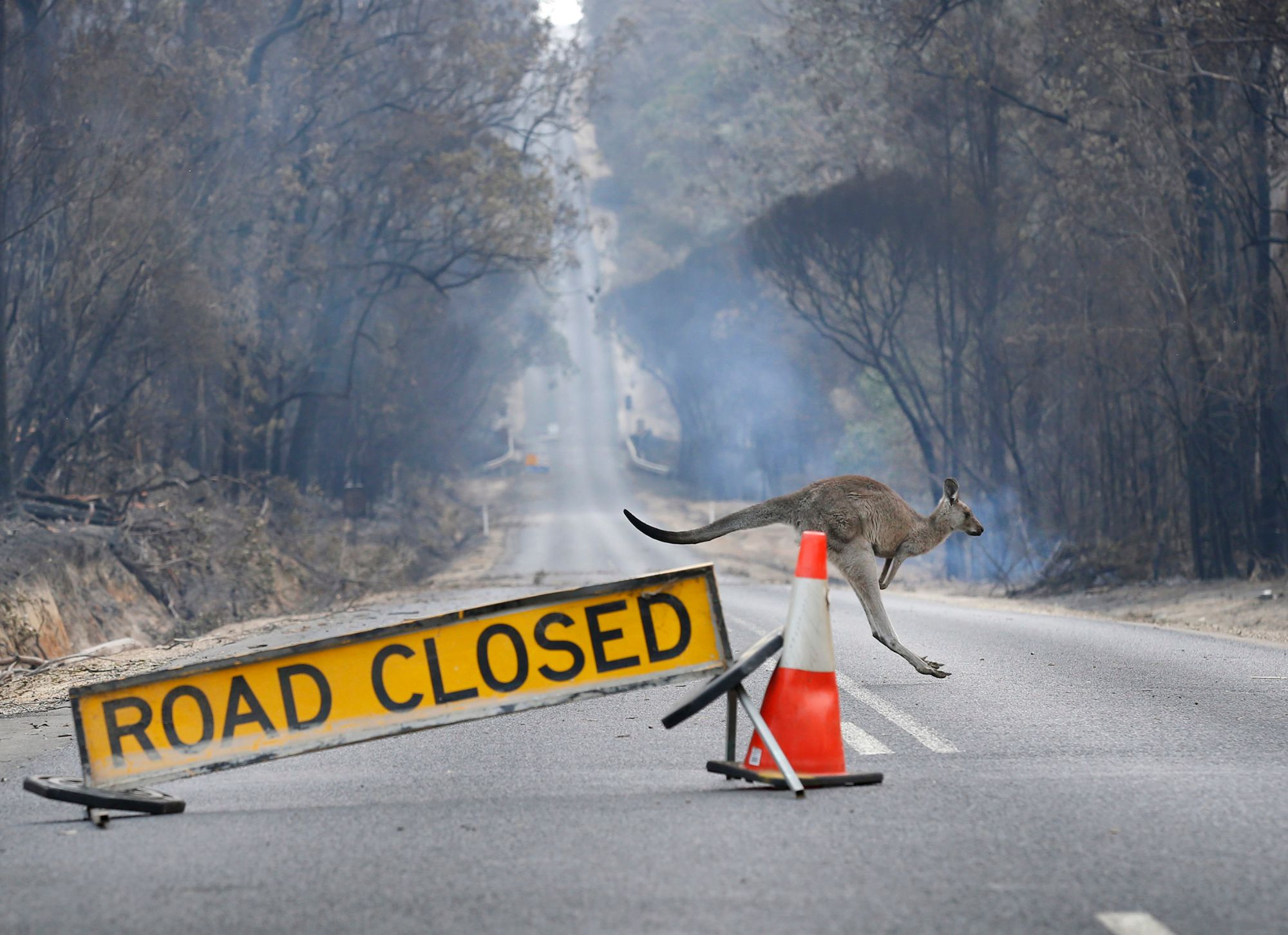
David Caird
Herald Sun
East Gippsland fires, Mallacoota township. Destroyed homes in the township. A kangaroo hops across a closed road looking for feed.
The story behind the shot
“From the safety of home in Melbourne, on holiday with my family, I watched the horror of the bushfires ravaging New South Wales and Victoria unfold through media outlets. When the popular Victorian holiday destination Mallacoota was nearly wiped out and cut off from escape, I called the office to lend a hand. After picking up a reporter from the office, we headed off as far as we could get by road, which was Lakes Entrance.
“There was no chance of getting in by road, as between us and Mallacoota was a raging and unpredictable inferno, so the call was made to hire a charter fishing boat for a four and half hour ride through rough seas – the only way in. By the time we arrived the clock had ticked over to 5pm and I was under great pressure to capture images of the devastation before the deadline of the Herald Sun’s first edition.
“Earlier, whilst waiting for the charter boat to arrive in Lakes Entrance, a contact in Mallacoota was established to drive the reporter and I to the areas most affected. It didn’t take long to discover how close the fire came to incinerating the town, the beach and all those on it, as we drove past house after house razed to the ground, with one street in particular having lost most of its houses.
“While I recorded the human tragedy of lost homes, the next element was the loss of wildlife. The abundant wildlife in the area was now displaced or injured or dead. While photographing a Closed Road sign with smoking trees behind it, a kangaroo jumped out of the ash forest beside me and across the road sign looking for safety and food. Later, at dusk, I happened upon a young girl walking her dog beside a large cable spool still on fire, which resembled the engine of a crashed jet airliner. This was just day one of six days on the ground covering one of the most remarkable stories of the 2019-2020 Australian bush fires.”
– David Caird
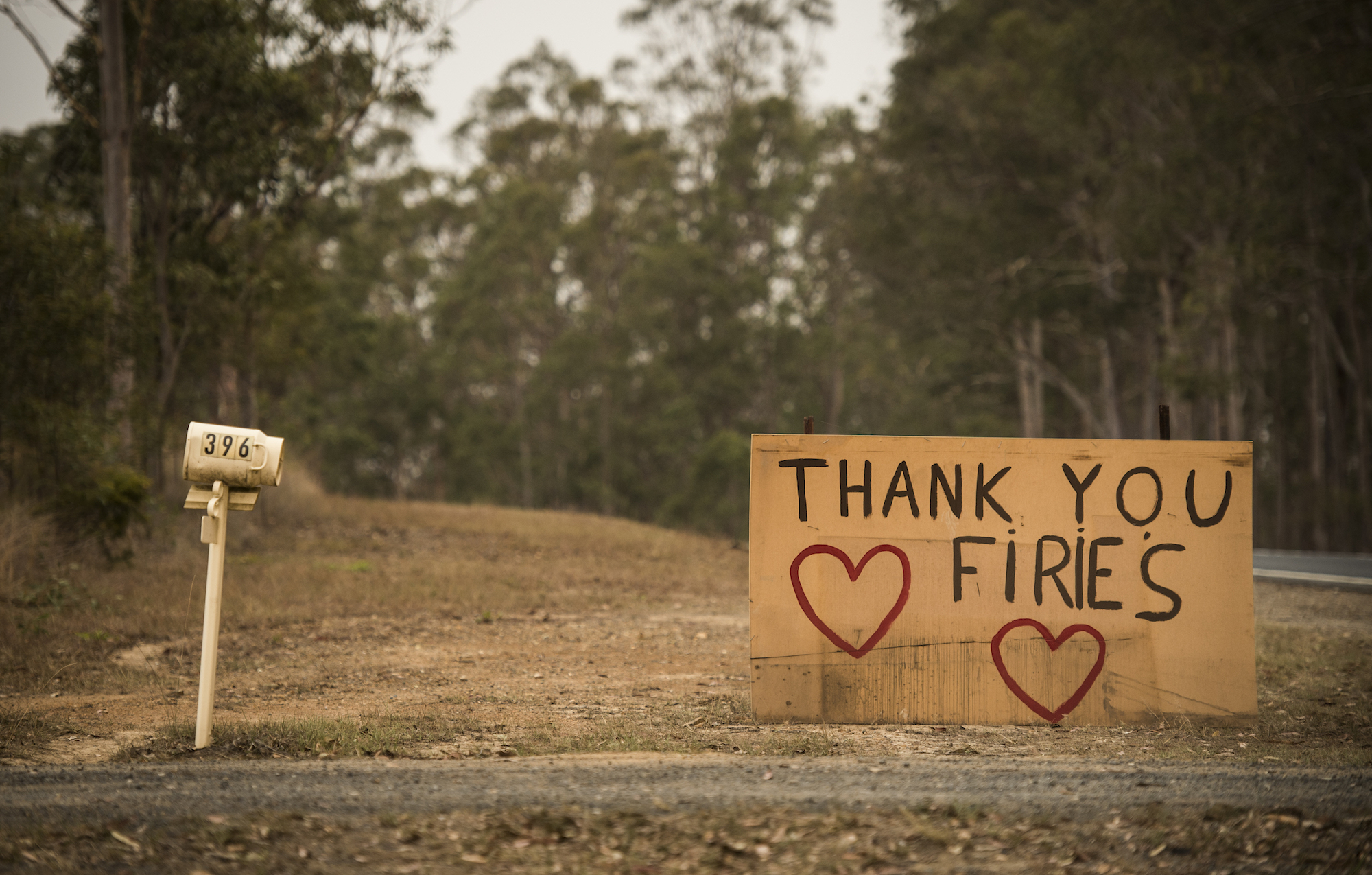
Wolter Peeters
The Sydney Morning Herald
A sign thanking the fire fighters at Yarravel.
The story behind the shot
“This particular photograph of the sign was typical of a lot of signs we saw in the area after several weeks of the bushfires. People from the community were really keen to start giving back and thanking the hard work of the volunteers in the fires out there. This was taken on the November 13 up near Yarraville, near Kempsey. It was one of those things at the end of a long day. I’d driven past a few of these signs during the day, but we were kind of busy covering other things and I almost drove past this one but thought, ‘oh, I should cover that one. I should get a frame of that’.
“It’s one of those pictures that helps tell the narrative of the whole story. On its own, it’s not much of a picture, but when you build it into everything else that’s being covered, it’s an important part to document. Consequently, this was one of the pictures that ended up being selected as part of the montage that was projected onto the Sydney Opera House, so that was kind of nice. It was great to see people being thanked and the volunteers being thanked in that way with that projection.
“Covering fires and being embedded with the locals can become very tenuous in some circumstances. But the whole time I was in the town, and being one of the few media crews to get in early, I felt welcome and accepted. I think this was because there were no deaths recorded during the fire, plus a sense that us being there and putting their plight onto the front pages of newspapers around Australia, would start to force the Federal and state governments to speed track a rescue package. The friendliness and generosity of locals and businesses made me feel welcome and a ‘we’re in it together’ mentality.”
– Wolter Peeters
